How mind maps make researching easier

When you’re first brainstorming a new idea or researching a topic, you don’t know what ideas you’re going to come up with. As such, it’s hard to plan a layout for the information in a typical report format. A mind map allows you to free yourself from a predefined structure, and lets the ideas grow as you develop them, ensuring that you don’t lose track of your thoughts.
- What is a mind map?
A mind map is a visual tool for structuring thoughts. It can be used on an individual or team basis, and results in a hierarchical diagram of everything that has been discussed. The diagram is focused on a single element, where it is discussed, ideas are written down, spreading outwards from the original focus. This spreading and recording of key ideas helps trigger further ideas, and results in their natural grouping.
Records of the use of mind maps date back as early as the third century, and the idea of visually plotting one’s ideas has been used in many different ways throughout history. Through this time, the concept did not have a specific name, and it was only in the 1970’s that British psychologist Tony Buzan popularized the term mind map.
- When to use a mind map
Mind maps are extremely versatile and have a number of potential uses. A mind map’s hierarchical and graphical nature also assists one in memorizing the information you lay down on it, giving them a number of applications:
- As a study aid — you were quite likely taught how to use one growing up, but their visual element is great at triggering memories.
- Researching new products and developing new ideas — as you discuss topics, they are recorded, allowing you to track idea development more easily, and for visualization for multiple people.
- As a problem-solving tool — helpful in brainstorming problems and building on ideas to determine solutions.
- As a presentation method — one is able to show how a process was developed, visualizing alternatives and topics discussed.
While useful for an individual to come up with ideas on their own, a mind map is a great tool for teams that are brainstorming together, ensuring that everyone’s ideas are heard and recorded in a logical, easy to absorb manner.
- Making a mind map with a template
Making a mind map is a fairly straightforward task, but there are a few steps and hints that you can follow to ensure you get the most out of the exercise. To make things easier to understand, we’re going to demonstrate by creating our mind map. While you can jot one down on a piece of paper, there are a number of advantages to be had when using an online mind map maker. So, for our example we’ll use a mind map template in Miro to demonstrate each step.

Step 1: Start with a focus
You’re creating a mind map for a specific reason, whether it’s a subject that you’re investigating, or information you need to present. This idea or thought needs be the center of your mind map. As such, most mind map makers will place your focus idea, or goal, in the middle of the page.
For our example, we want to perform research, with the goal to launch a mobile app for an existing software product.
Pictures and visual elements are much easier for the human brain to remember, and are more likely to trigger associated thoughts than just words. Miro’s visual workspace allows you to upload images, gifs, etc., making it easy to include them in your mind map. Consider using a picture to represent your mind map’s focal idea.

Step 2: Plot sub-groups
From your main idea, you will determine key areas, which are sub-groups of your focus. These can be extremely varied or similar, as long as each group is a distinct subset of the main focus. These groups are connected as lines to our focus.
For our user research, we start quite broad and choose to consider the following three topics:
- Customer Development — we want to confirm that our app will be beneficial to our clients and that the added value will result in maintained or increased profits.
- Trends — to ensure our user experience is up-to-date, we want to discuss new trends that could be implemented.
- Competition — to help understand the current market and identify ways to make our product better, we must analyze competitors’ products.
Don’t be concerned if you only have a few sub-groups. Ideally, you will have less than five, but each mind map has its own requirements, so this can vary.

Group tips:
- To help reinforce the grouping, make use of different colors for each group. You can either draw the lines in different colors, or write or highlight the words in separate colors.
- If you’re not sure what groups to create, try to answer questions about the topic, for example, how you want to perform the research, what results you expect. Each question can be associated with a word and used a group.
Step 3: Develop further
Each of your sub-groups will likely have their own set of sub-groups. For each of your areas, consider what they mean, and what ideas you feel link to that topic. Look at one group at a time, but come back to a group if there is more to add to it.
When we consider our groups, the next tier for each one could be:
- Field visits — how do users use similar apps now in their day-to-day job?
- Beta testing — to get feedback from customers to the MVP version.
- UX design — look at recently released apps to see what works well.
- Integrations — what other services do, which our users use, where there would be a benefit integrating with our app.
- Market trends — read latest blogs and articles to keep app design up-to-date.
- Features — what features competitor products offer.
- Traffic estimate — how popular competitor products are among users.
We’ve only included a few possible expanded groups here. No doubt, you can easily come up with several more for our fictional situation yourself. Add as many as you feel is necessary for your mind map.

Further development tips:
- For each branch and new item that you use for your mind map, try make use of a single keyword, or keyword pair instead of writing entire phrases. It makes your mind map easier to view and manage, but also prevents you from restricting your thoughts too much, leaving terms open to interpretation.
- Mind maps are often made by writing each keyword on a line. Some people prefer to have the keyword at the end of a line. Both ways work well, and are left to user preference. Try using both to determine which works better for you.
Step 4: Expand
At this stage, you’ve done all the groundwork, and you just need to add as many ideas as you can. Remember, you can always cull ideas at a later stage or move them, so don’t hold back. Record everything that you think of or that is discussed.
As you continue, you might find it easier to focus on a sub-group and fully populate it. Other times, especially when working in teams, people are focusing on different areas at the same time, and you will find as you jump from one group to the next, both approaches will give you the same result.
If necessary, don’t be afraid to add a whole new sub-group to your main focus. There may be something which you didn’t think of earlier, or an existing branch which you have developed to an extent that you feel it deserves to be on its own.
Our example mind map is far from complete. We can expand on some of the points as follows:
- Current users — clients who currently use our software.
- Potential — identify users who use similar apps.
- Online interviews — for those customers who are based in other countries.
- Observation in the users’ offices — for customers who are close to the office.

Expansion tip:
While you’re working on a mind map, you might find that it generates tasks that need to be completed. You can easily assign tasks to people in your team by encircling certain points and writing a team member’s name and a due date.

- How to save time when making a mind map
Mind maps are a tool to help you work more effectively. Effectiveness is minimized if you spend the whole day working on a single mind map. Your mind map doesn’t have to be perfect. Your mind map doesn’t have to be a work of art. With practice, you’ll figure out what works best for you, but don’t be concerned about finding the perfect image to represent your thought, and don’t worry about colors clashing. What’s important is putting the ideas down. If you need to present the results, you can tidy it up at a later stage, but the most value is found in the creation process, and this should be easy.
As we’ve shown you, a good way to speed up your mind map making is to use a visual workspace instead of pen and paper. The pages expand to fit the extent of your ideas, and you don’t have to waste time trying to plan your layout. You can also easily delete, edit and move ideas on the board. They have the added benefit of allowing remote teams to work together on the same mind map.
If you’re looking for more information or tips about making mind maps, consider checking out one of the following links:
- TonyBuzan.com — learn from the master, Tony Buzan’s website offers a number of additional resources for making the perfect mind map.
- IQMatrix.com — a very extensive article with more information than you could ever need.
- Incorporating mind maps into your work
Different people will often come up different ideas or groups that they feel are the key areas of focus for a mind map. Given the same inputs, different people will all develop a different looking mind map, but the process will still generate the same end items, just grouped differently. That is not something to worry about, though.
One of the great things about mind maps is how much freedom you have with them, both in potential uses, and how you develop them. The more you practice, the more you’ll find a style that suits you, and new ways to use them.
Mind maps are quick and easy to use. Try find new ways to implement them into your work.
Miro is your team's visual platform to connect, collaborate, and create — together.
Join millions of users that collaborate from all over the planet using Miro.
Keep reading
Don’t let ideas die post-retro: 5 ways to make retrospectives more actionable.
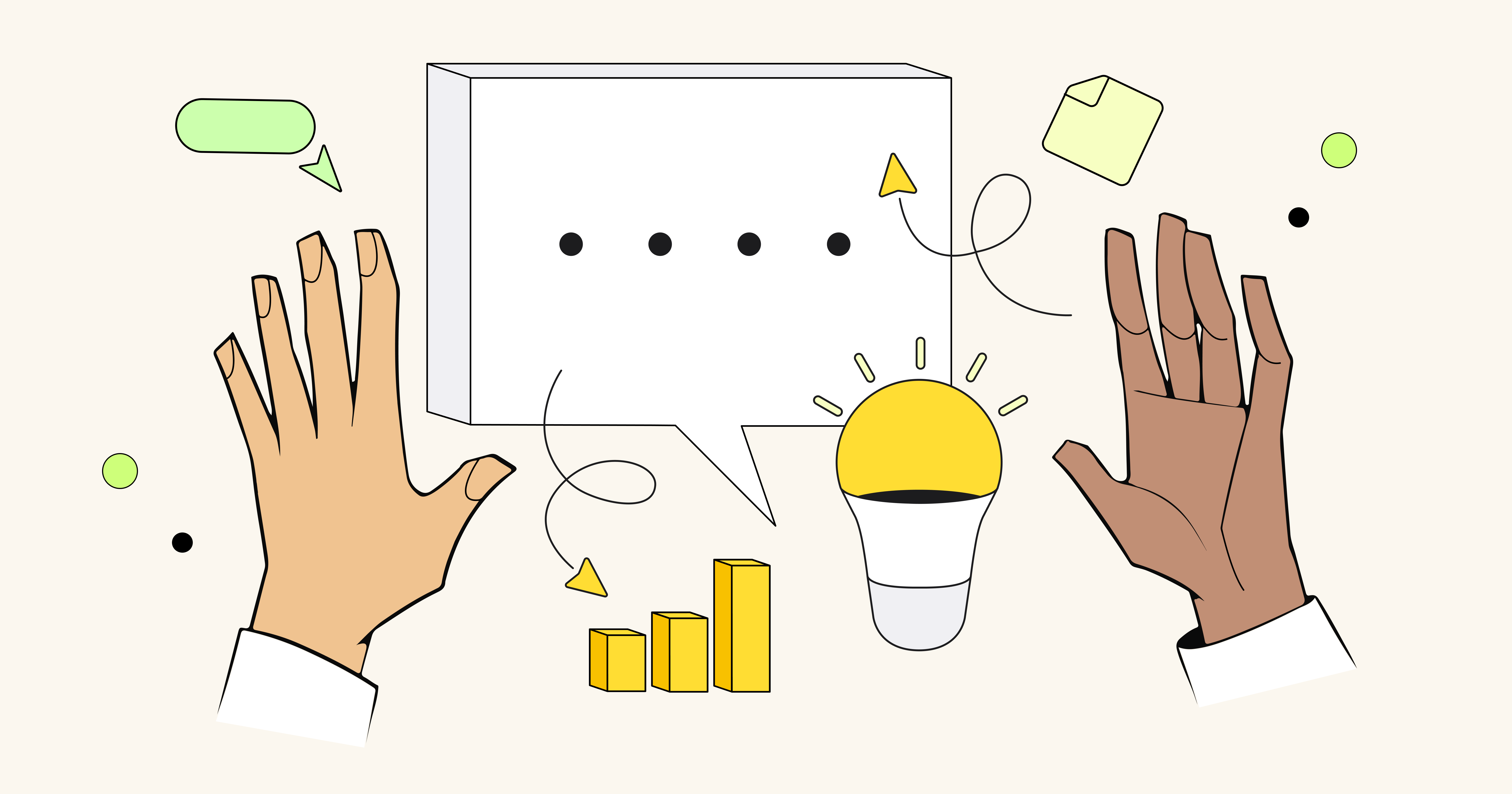
Removing the hassle of brainstorm documentation with Miro + Naer

From ideas to execution: 5 ways to go beyond brainstorming to bring ideas to life
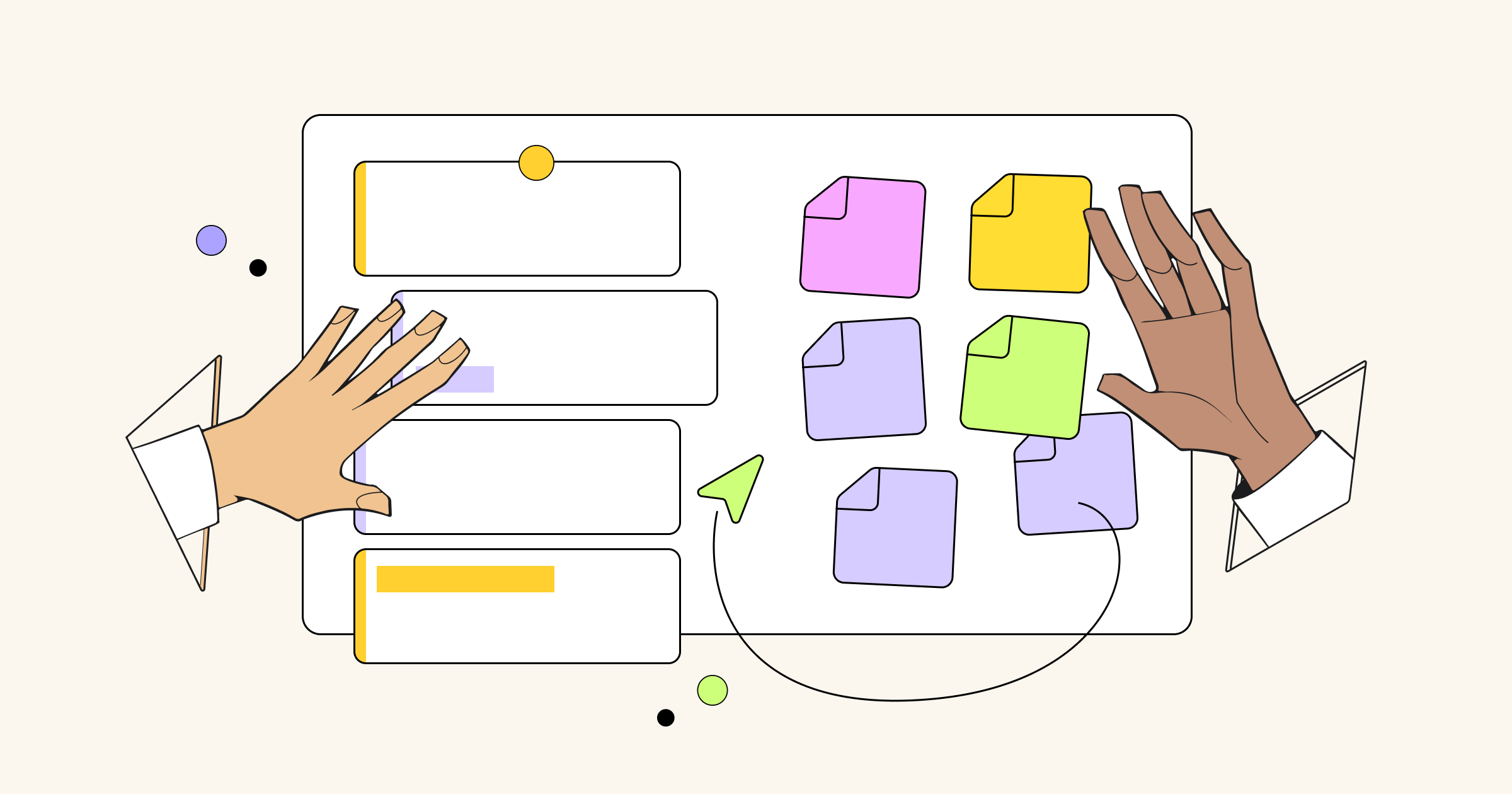
Narrowing It Down: Mind Mapping 101: Home
What is mind mapping, mind mapping is a learning tool that can be used to flush out your ideas and organize your thoughts using a diagram. you take your central idea and write out what you know about that particular area. ask the who, what, where, and why questions surrounding your topic area. list key people, date ranges, policies, and even geographical areas that influenced the development of your topic area. creating a mind map gives you the space to remember what you know, and find gaps for what you would like to learn. it is a process that builds confidence in the research process and provides a guide for you to use while searching online and within the databases. it is a great addition to your search strategy rule book. , hazel wagner | tedxnaperville.
Topic Development From a Different Vantage Point
Choosing a topic can be difficult - where do you even start? Below are some videos and tutorials that will help you to understand the research process and how to settle on a topic for your paper that you can further research. Remember - be flexible when doing research - the topic you start with may change by the time you write your paper!
NOTE : These tutorials are only available for currently enrolled LSU students, faculty, and staff. When attempting to access tutorials from off campus, users will be prompted to login to their myLSU Account.
- Video: The Research Process
- Developing a Research Focus
- Choosing a Topic
- Video: How to Narrow Your Topic
Download the MindMap and WordBank
- MindMap and Word Bank
Download Concept Mapping Guide by Center of Academic Success
- Concept Mapping
Mind Mapping and Word Banking

In addition to mind mapping, a word bank is a great tool to use as you are searching online. During your background research process, you will come across various phrases and terms that journalist, experts, and scholars use to discuss your chosen topic. Utilizing this tool helps build a bank full of key words and s earch terms that can be used interchangeably with boolean operators ( AND, OR, NOT or AND NOT) to search for records within the databases.
The difference between mindmapping and concept mapping, what is a concept map, it gives the relationship between individual ideas, words, or images that create a bigger picture. they depict requirements, cause and effect, and contributions between items. concept maps are the best tool for developing logical thinking, breaking down complex systems, and understanding specific ideas' roles within more prominent topics. - mind manager.com .

Table image from ZenFlow Chart
African and African American Studies Librarian

Online Mind Mapping Tools

Literati by Credo : Virtual MindMap
- Credo Reference This link opens in a new window Credo Reference is a general reference solution for learners and librarians. Offering 551 hundred highly-regarded titles from over 70 publishers; Credo General Reference covers every major subject. Credo Reference is an online reference service made up of full-text books from the world's best publishers. Whether you're working on a research paper, trying to win trivia or just curious, Credo Reference has something for you.
- Last Updated: Oct 4, 2023 2:18 PM
- URL: https://guides.lib.lsu.edu/c.php?g=1206028
Provide Website Feedback Accessibility Statement
- Search Site
- Campus Directory
- Online Forms
- Odum Library
- Visitor Information
- About Valdosta
- VSU Administration
- Virtual Tour & Maps Take a sneak peek and plan your trip to our beautiful campus! Our virtual tour is mobile-friendly and offers GPS directions to all campus locations. See you soon!
- Undergraduate Admissions
- Graduate Admissions
- Meet Your Counselor
- Visit Our Campus
- Financial Aid & Scholarships
- Cost Calculator
- Search Degrees
- Online Programs
- How to Become a Blazer Blazers are one of a kind. They find hands-on opportunities to succeed in research, leadership, and excellence as early as freshman year. Think you have what it takes? Click here to get started.
- Academics Overview
- Academic Affairs
- Online Learning
- Colleges & Departments
- Research Opportunities
- Study Abroad
- Majors & Degrees A-Z You have what it takes to change the world, and your degree from VSU will get you there. Click here to compare more than 100 degrees, minors, endorsements & certificates.
- Student Affairs
- Campus Calendar
- Student Access Office
- Safety Resources
- University Housing
- Campus Recreation
- Health and Wellness
- Student Life Make the most of your V-State Experience by swimming with manatees, joining Greek life, catching a movie on the lawn, and more! Click here to meet all of our 200+ student organizations and activities.
- Booster Information
- V-State Club
- NCAA Compliance
- Statistics and Records
- Athletics Staff
- Blazer Athletics Winners of 7 national championships, VSU student athletes excel on the field and in the classroom. Discover the latest and breaking news for #BlazerNation, as well as schedules, rosters, and ticket purchases.
- Alumni Homepage
- Get Involved
- Update your information
- Alumni Events
- How to Give
- VSU Alumni Association
- Alumni Advantages
- Capital Campaign
- Make Your Gift Today At Valdosta State University, every gift counts. Your support enables scholarships, athletic excellence, facility upgrades, faculty improvements, and more. Plan your gift today!
Developing a Research Topic: Concept Mapping
- Concept Mapping
- Developing Keywords for Searching
- Boolean, Truncation, and Wildcards
- Topic Ideas
- Writing a Research Question
Concept Map / Mind Mapping
What is a concept map.
A concept map is a visual representation of what you know about a topic. Concept maps help you organize your thoughts and explore the relationships in a topic. Use a concept map to organize and represent what you know about a topic. Explore the connections between elements of the topic.
Why use a concept map?
Concept maps can be used to develop a research topic. They are a useful brainstorming tool.
Concept maps can be used to study. Mapping what you know about a subject and examining the relationships between elements help you develop a greater understanding of the material.
How do I create a concept map?
- On a whiteboard
- Any way that works for you!
How do I organize the map?
Most of the time you start with the central idea, topic, or subject. Then you branch out from that central point and show how the main idea can be broken into specific subtopics. Each subtopic can also be broken into even more specific topics,
Make a Research Appointment
Click Make a Research Appointment to schedule a meeting with a librarian!
Organize what you know by subtopic in a topic map.

Use the topic map to define your research topic.
For example: geography - local travel - rail - variants - rail systems - designs & availability - emissions - research & evidence

Make a topic statement or research question.
I am researching the environmental impact of using commuter rail systems in cities.
How does using commuter rail systems in cities affect the environment?

Concept Map, Mind Mapping
Example concept map.

- Next: Developing Keywords for Searching >>
- Last Updated: Sep 18, 2023 11:56 AM
- URL: https://libguides.valdosta.edu/research-topic
- Virtual Tour and Maps
- Safety Information
- Ethics Hotline
- Accessibility
- Privacy Statement
- Site Feedback
- Clery Reporting
- Request Info

- X (Twitter)
What is a Research Mind Map, and how can it help you?
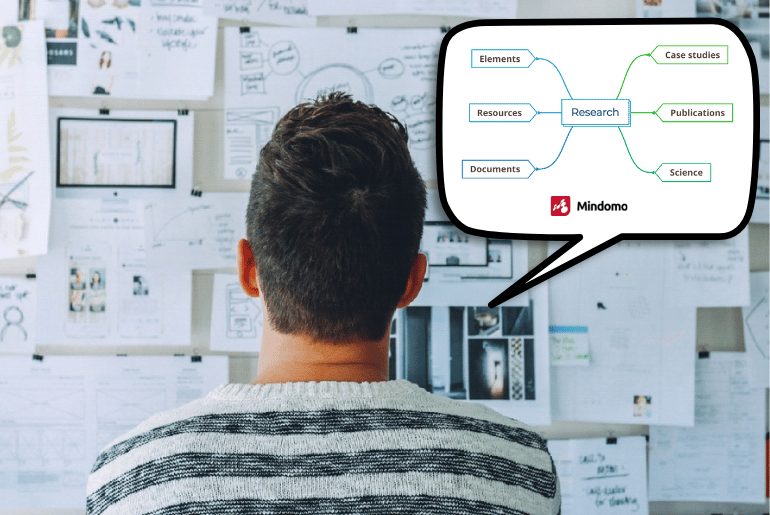
Anyone who is in research, especially in higher education or product development, should know the power of mind maps already. These are sometimes explicitly referenced as a research mind map. However, instead of starting to draw everything out on a piece of paper, it’s best to work with a diagramming tool . Becoming a master of mind maps will help to unlock the power of visual representation and learning .
Many people believe you can only use a mind map in early education or business. Yet mind maps are used all the time whether we know it or not. Imagine the last time you grabbed a piece of paper and started writing down notes. You’re in a class with these notes, and you start drawing shapes around some keywords. You then start to draw arrows or lines to other words from this key central point. In essence, this comes from you as a visual learner, and you’re working on building your first mind map template.
This note-taking endeavor will allow you to build a research mind map in no time. All you need to do is reinforce your understanding of how mind maps can be used in education . That’s because it will be your first step in using a mind map for research. Make sure to understand the different stages of a traditional mind map as well.
How do you write a mind map for research?
Traditional mind maps are all about brainstorming your ideas. Most mind map examples out there showcase this, yet when it comes to research, we take the opposite direction. We want to take a more focused approach and represent that in our mind map template.
With the core topic in mind, it’s even best to consider using an image in the center. But, again, it helps to bring a different medium to your mind map examples.
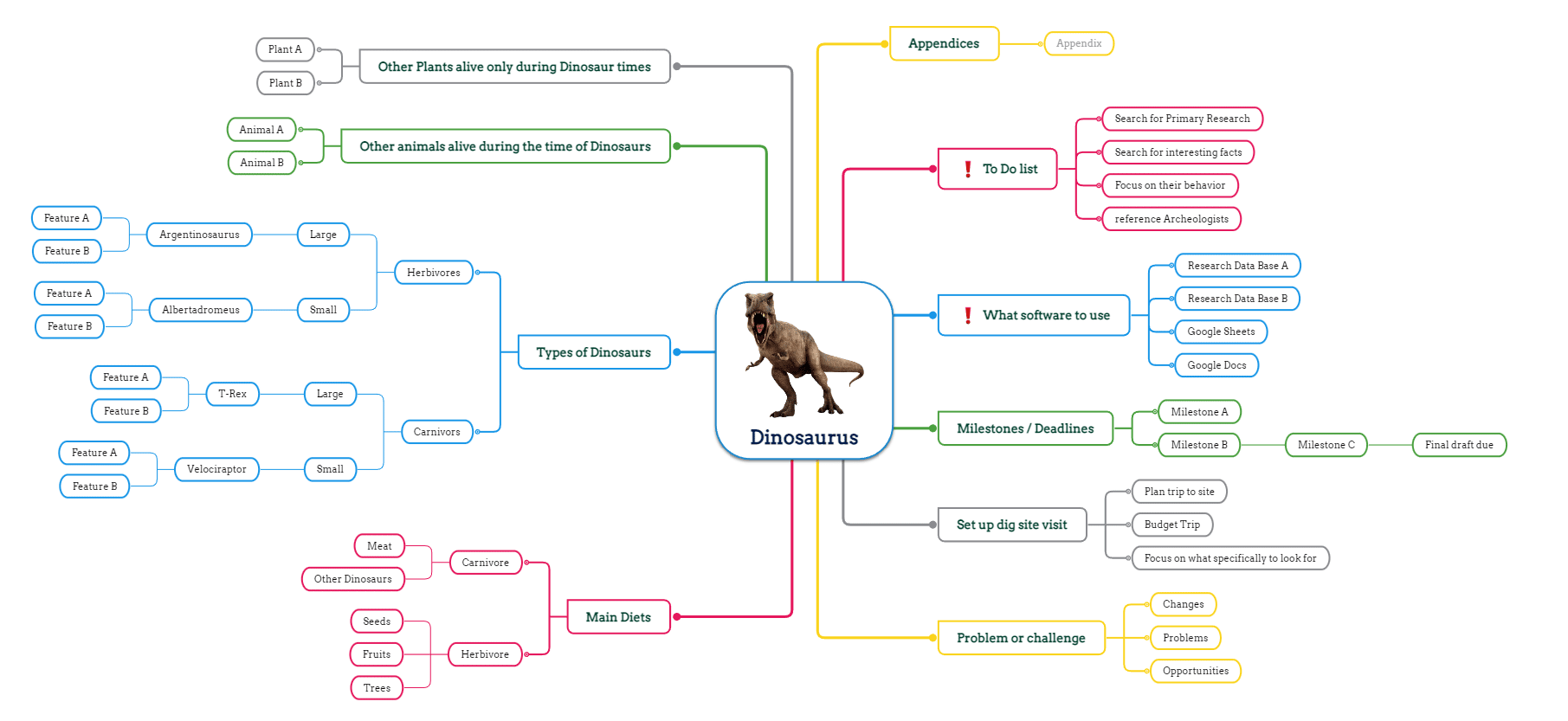
In this case, our focus will be dinosaurs. This research mind map will end up acting not only as a place for research but an outline of tasks. This helps to provide a completely holistic approach and has everything on one digital mind map .
Once you find your focus – you want to build out your subgroups. These will be that mix of research areas, deadlines, to-do lists, and other components that are part of the research. It should have the core research problem being looked into.
Keep in mind to stay focused with this digital mind map. You don’t need any special mind-mapping software for research. Just find the most flexible and feature-rich diagramming tool possible, such as us at Mindomo.
What does research include?
It doesn’t matter if you’re looking into academic research or professional research. If you’re looking into product research at a company, it will have similar data categories. Research is a way to increase our overall collective knowledge. It is done to evaluate a hypothesis as well as generate questions for additional research. Part of doing research is to combine it all together, the knowledge, data, references, and inferences into a presentable format.
A research mind map helps with the collection of the components of research. This includes:
- Documentation
- Information
- Data collection
- Analysis results.
There are different methodologies that one can use when conducting research as well. These are further broken down into whether you’re looking for qualitative research vs. quantitative research.
Sources of data for research come in three different formats. Again they are the same for academic or professional uses. First, we have first-party or primary data, which the researcher is collecting. A classic example is the collection of data through a survey.
Then there’s second-party or secondary data which is the use of existing verifiable data sources. This helps to validate primary data at times. There are also third-party data, which isn’t always used in research. This is more about reference data that doesn’t directly tie into what the research is about.
Why use a mind map for research?
When using mind mapping software for research, it’s all about organization and reducing chaos. From there, the benefits of using a digital mind map become easier to see.
It becomes your organizational tool
As mentioned a few times, here is where everything comes together. This is your research planner, as well as your data sets. You can use one side for pure research information and the other side for tasks and to-do lists.
It’s easier to see relations and patterns
A research mind map will have all the data in one place. The inferences to prove the hypothesis will be easier to handle since you don’t need to switch between screens.
Excellent for collaboration
Research is best done in groups. Having a mind map online helps with this collaboration and can grow as the research data grows. It’s also great to use as an education mind map when training future researchers. Once all the research is published, it’s easy to convert the research mind map into an education mind map.
Just what is needed for future research
Using a research mind map built off of a mind map template means the ability to start new research immediately. In addition, a mind map template built out of a diagramming tool helps speed up administrative tasks and gets you focused on the research portion.
Finding the right diagramming tool
Mindomo helps you create a mind map template that can be customized to become a research mind map. It’s an excellent option for those that are looking for mind-mapping software for research and starts out free. You can easily build out your mind map online directly and start your collaboration today.
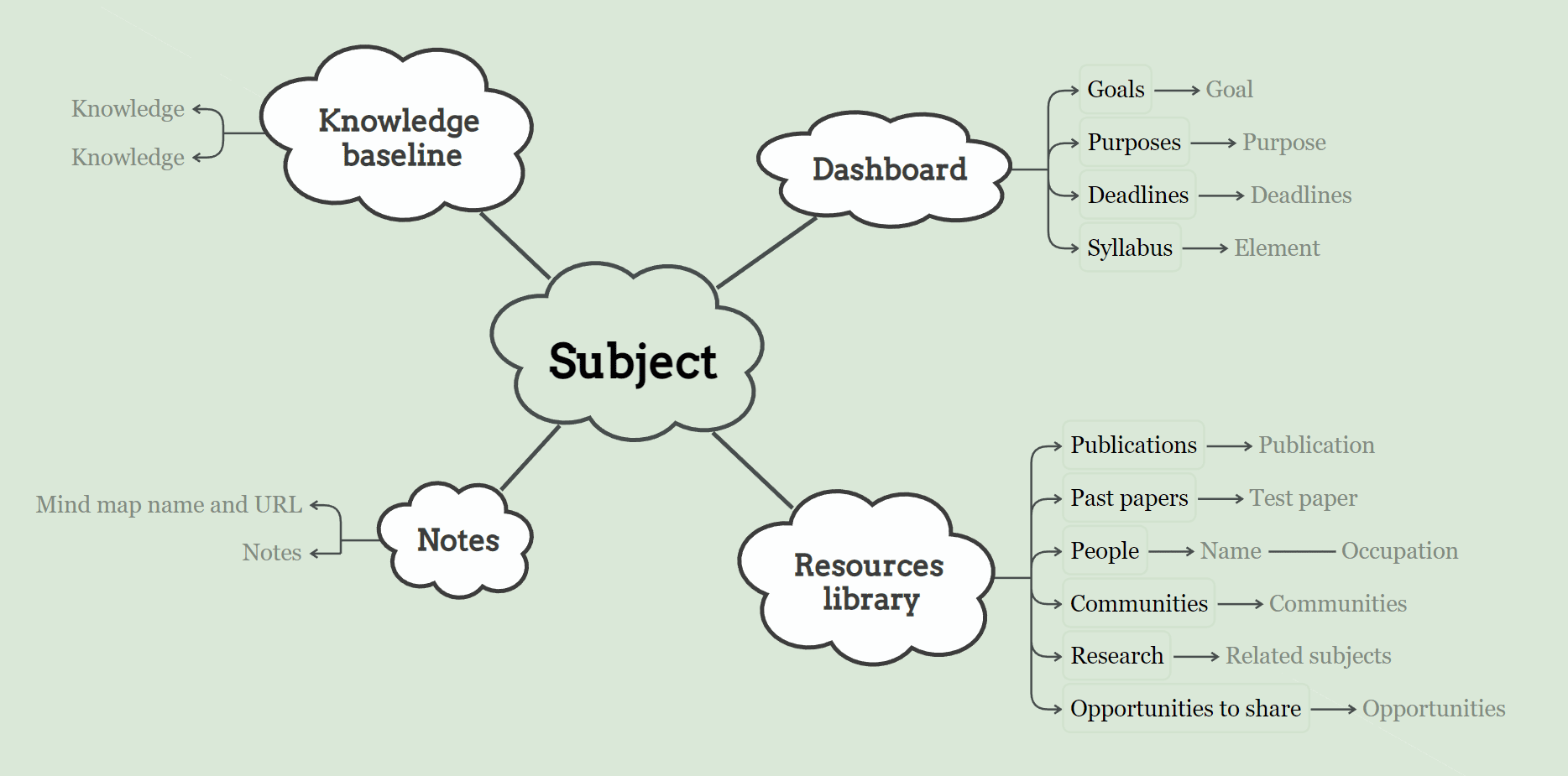
There are also plenty of Mindomo integrations possible to help integrate datasets and information as needed. No need to have one space for data collection, another place for structure, and another for tasks and deadlines. A research mind map will only help enhance your output, so why not branch out into this today?
Keep it smart, simple, and creative! The Mindomo Team
Related Posts
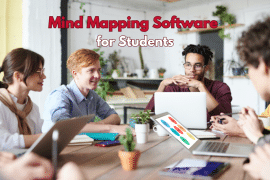
Unlocking the Power of Mind Mapping Software for Students

Unlocking the Power of Biology Mind Maps: A Visual Learning Revolution
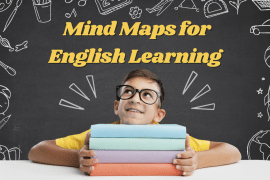
Improving English Fluency: The Role of Mind Maps for English Learning
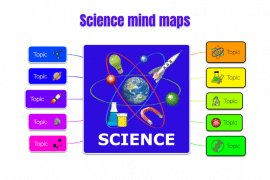
Science Mind Maps: Harnessing the Power of Mind Maps for Science Research
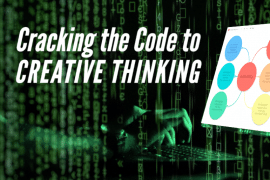
Cracking the Code to Creative Thinking: Ignite Your Brain and Unleash Your Ideas
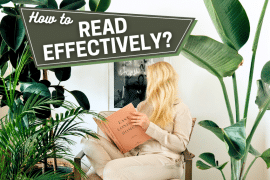
How To Read a Book Effectively and Digest Information – Growth Reading
Write a comment cancel reply.
Save my name, email, and website in this browser for the next time I comment.

Productivity
How to use mind mapping, this simple organizational technique could deliver powerful benefits..
Updated November 20, 2023 | Reviewed by Gary Drevitch
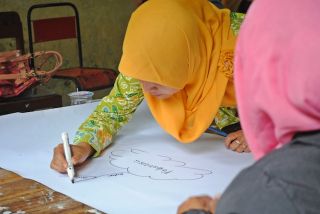
Cowritten by Kelsey Schultz and Tchiki Davis.
Mind mapping is a technique through which you develop and visually organize thoughts, ideas, and information. This technique involves identifying a central topic (often represented as an image) and creating branches indicating the relevant categories that are related to the central topic extending radially from the central idea (Budd, 2004).
A mind map essentially provides a scaffold that helps structure complex concepts and allows for a better understanding of the relationship between concepts (Zhao et al., 2022). In other words, a mind map allows you to take advantage of the vast neural real estate dedicated to visual processing and leverage it for breaking down complex topics into digestible or actionable bits.
The process of creating mind maps can have numerous benefits. For example, a mind map allows you to get into the details of a concept without losing track of the big picture. Mind maps can also help show the non-linear relations between different categories within a given concept. Additionally, mind maps can be an optimal method for collaborative brainstorming .
Psychological research has also shown that mind mapping is an excellent tool for enhancing learning and understanding. For example, in a sample of 120 8th-grade students, researchers found that students who were taught using a mind-mapping technique performed better on a subsequent test than students who were taught using traditional methods (Parikh, 2016).
Other studies have found similar results. For example, a study involving college freshmen taking a writing class showed that students who were taught to use mind maps to organize their ideas made greater improvements in their writing ability than students taught to organize their ideas using traditional methods (Al-Jarf, 2009).
How to Do Mind Mapping
- Define your central topic. First, consider what the focus of your mind map should be and write it out in the center of the page. For example, if you are mind mapping out a to-do list, you would simply write “to-do list."
- Identify your first-level concepts or topics. Next, consider the broader categories related to your central topic. These categories will become the first nodes branching off from the central point of your mind map. Sticking with the to-do list example, your first-level categories might include home, work, errands, and personal health.
- Expand your branches. Each of the first-level categories you defined will branch off into different sub-categories, or second-level categories. For example, branches from the first-level category “home” might include cleaning and preparing for visitors. Each of these second-level categories might also have branches. For example, the category “cleaning” might include vacuuming, laundry, and dishes, and the category “preparing for visitors” might include changing the sheets and making snacks. Each branch can expand as many times as necessary.
- Add images or annotations. Many people find it helpful to include images that represent different categories or different levels of priority. Using annotations or different colored pens when creating your mind map can also be a helpful way to indicate urgency or to set your different categories apart.
Pen and Paper
Pen and paper are easily accessible and provide ample flexibility in how your maps are structured. You can keep them simple with just a single pen and notebook paper, or you can get creative with different colored pencils, pens, stickers, and drawings. It might be helpful to get erasable pens if possible, in case you decide to reorganize some aspects of your map. Computer software can also be a great tool for mind mapping because it allows you to organize a vast amount of information in one convenient place.
Adapted from a post on mind mapping published by The Berkeley Well-Being Institute.
Al-Jarf, R. (2009). Enhancing freshman students’ writing skills with a mind-mapping software. Available at SSRN 3901075.
Budd, J. W. (2004). Mind maps as classroom exercises. The journal of economic education, 35(1), 35-46.
Parikh, N. D. (2016). Effectiveness of teaching through mind mapping technique. The International Journal of Indian Psychology, 3(3), 148-156.
Zhao, L., Liu, X., Wang, C., & Su, Y. S. (2022). Effect of different mind mapping approaches on primary school students’ computational thinking skills during visual programming learning. Computers & Education, 181, 104445.

Tchiki Davis, Ph.D. , is a consultant, writer, and expert on well-being technology.
- Find a Therapist
- Find a Treatment Center
- Find a Support Group
- International
- New Zealand
- South Africa
- Switzerland
- Asperger's
- Bipolar Disorder
- Chronic Pain
- Eating Disorders
- Passive Aggression
- Personality
- Goal Setting
- Positive Psychology
- Stopping Smoking
- Low Sexual Desire
- Relationships
- Child Development
- Therapy Center NEW
- Diagnosis Dictionary
- Types of Therapy

Understanding what emotional intelligence looks like and the steps needed to improve it could light a path to a more emotionally adept world.
- Coronavirus Disease 2019
- Affective Forecasting
- Neuroscience
- Search the site

What is Mind-Mapping? The Ultimate Guide to Using This Powerful Tool
Anthony Metivier | March 5, 2024 | Podcast , Thinking
Podcast: Download
Subscribe: Apple Podcasts | RSS
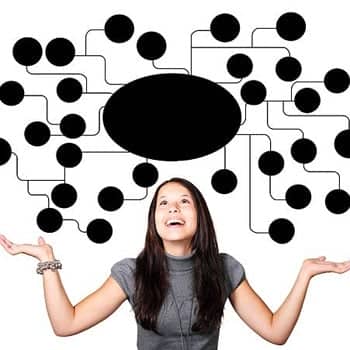
Well, imagine you’re listening to a history lecture. Instead of taking notes , your fingers itch to make a mindmap of World War I events as you hear them.
But how do you draw mind maps?
And, can mind maps alone boost your memory, learning power, and creativity?
In this article, you’ll explore a complete guide to mind mapping, how to draw one, including multiple examples of mind maps. We’ll also examine whether mind mapping alone can improve your brainpower and creativity, and what else you can do.
Here’s what I’ll cover:
What is Mind Mapping?
- Benefits of Mind Mapping
Who, When, and How to Make a Mind Map
Tools you can use for mind mapping.
- Can Mind Mapping Alone Improve Your Memory?
- How to Combine a Mind Map with the Major System
Mind mapping is a simple, visual way to organize your ideas for better clarity and recall . Mind maps focus on only one central concept or idea and are based on radial hierarchies and tree structures.
What does all that mean? Let’s get into the details.
A Brief History and Definition of Mind Mapping Methods
The practice of drawing radial maps to map information goes back several centuries.
Some people credit the first mind maps to the 3rd-century philosopher Porphyry of Tyros . Ramon Llull , Leonardo Da Vinci, and Isaac Newton also used mind mapping techniques. Much later, in the 1960s, scientists Allan Collins and Ross Quillian developed the semantic network into mind maps.

However, it was psychology consultant Tony Buzan who first popularized the term “mind map.” Buzan drew colorful, tree-like structures called radial trees where a central topic branched out to several sub-topics.
The Tony Buzan Learning Center defines their Mind Map as “a powerful graphic technique which provides a universal key to unlock the potential of the brain. It harnesses the full range of cortical skills – word, image, number, logic, rhythm, color, and spatial awareness – in a single, uniquely powerful manner.”
These pictorial representations introduced by Buzan are now being used by students, teachers, engineers, psychologists, and others in many ways . His Mind Map Mastery is probably the best book he produced on the topic.
So, what does a mind map look like?
Examples of Mind Maps
To get the most benefit out of mind mapping or any kind of mind-mapping exercise, make sure your mind maps are colorful and engaging. Don’t worry: the results can look analytical and artistic at the same time.
To help you see what I mean, here are some great examples of how fun and engaging mind maps can be. Some of them look messy — but look deeper and you’ll see they are examples of detailed trains of thought.

Source: Tony Buzan Learning Center

Source: MindMapArt

Source: BiggerPlate
These fascinating examples are colorful, though in some cases, also quite visually overwhelming.
That’s why I’ve pared down my own style, and am glad I got Tony Buzan’s seal of approval after doing so:

Anthony Metivier with a Buzan-style Mind Map
But you might be asking: aren’t these the same as spider maps, concept maps , and other such visualizations?
No. There are some key differences.
Why are Mind Maps Effective?
Nobel prize winner Dr. Roger Sperry’s research proved that visual forms of note making are more effective than written methods.
He showed that the brain is divided into two hemispheres that perform cortical skills like logic, imagination, color recognition, and others. These functions work in sync when you mindmap your thoughts, creating a lasting impression in your brain.
Mind maps are effective because:
- They nudge you to ditch the usual, bullet-point style of thinking, which pushes you to use your creativity.
- They are presented in a brain-friendly format — and people can grasp the linkages quickly.
- They let you see the bigger picture.
- They keep you focused on key issues.
- They give you time for “diffuse thinking” as you pause to change colors and reflect on keywords and images.
- And, they help you retain and recall more information through patterns and associations.
Next, let’s look at why mind mapping can be beneficial.
Benefits of Using a Mind Mapping Method
Years of research have gone into testing the effectiveness of mind mapping.

In a 2005 study by G. Cunningham , 80% of the students agreed that mind mapping helped them understand science concepts better.
Paul Farrand proved the efficacy of mind mapping as a study technique and encouraged its use in medical curricula.
Mind maps are known to help you to improve your productivity at work, academic success, and even to manage your life.
Here’s how you could apply it in your day-to-day life:
- Note Taking: You can map out notes from a podcast, a project discussion, or a seminar.
- Brainstorming: Helps in real-time collaboration with your team members to make informed business decisions.
- Studying: You can summarize books.
- Presenting information to an audience: Use it to get your team’s buy-in for anything through clear narratives.
- Problem-solving: Sometimes, it helps if you map out your current situation and your desired situation separately. This will help you come up with solutions easily.
- Increasing creativity: The words, images, and colors you use let you see the information from a very different perspective.
- Planning: Plan your holiday or your next sales strategy using mind maps.
- Language learning: Use a simple, 12-point mind map to combine 12 vocabulary words with the Major System. Here’s how:
Now that you have a fair idea of mind maps, let’s understand who should use it, as well as when and how.
Who Should Use Mind Maps?
Mind maps are particularly helpful for those who:
- (Or need practice becoming more visual.
- Deal with lots of information or a project that needs more clarity.
- Need to brainstorm for ideas from others to build a bigger project or solution.
Mind mapping has also proven useful for dyslexic students and those with ADHD .
When Should You Use Mind Maps?
Create mind maps when you need to achieve some goal — to understand your course material or project better, or to assess the ideas from brainstorming sessions .
Remember — mind mapping isn’t the end goal by itself.

And don’t spend too much time perfecting it. If it takes too long, it may hamper your creative thinking.
How to Make a Mind Map
Drawing a mind map is pretty straightforward.
For example, if you want to prepare a meeting agenda take a blank page and follow these basic steps:
- Draw a bubble in the middle of the page with the title of your meeting.
- Branch out with new bubbles from the central theme, with each branch representing the topics you want to address.
- Draw lines to connect each of them to the middle bubble.
- Add new ideas starting from the general to the specific.
- Repeat this for each subtopic branching out from the topics.
What are the Rules for Mind Mapping?
Mind maps are meant to be hierarchical and show relationships among pieces of the whole.
What are the guidelines you can use?
Tips for Drawing a Mind Map
Here are some mind mapping rules to make your mind map project expressive and compelling.
- Use colors, illustrations, and pictures: Some of the most effective mind maps have more doodles and symbols than words.
- Keep the topics and sub-topics brief: Stick to a single word each, or just a picture instead of long phrases or sentences.
- Keyword for branches: Name your branches or lines using a keyword each.
- Use different text sizes and alignment: Provide as many visual cues as you can to emphasize important points.
- Use symbols: Draw symbols like arrows and shapes to classify your thoughts.
- Space it out: Leave enough negative space between your idea bubbles.
- Highlight important stuff: Highlight important branches or bubbles with borders or colors.
- Create linear lists: You can create linear hierarchies using bullet points and numbered lists.
- Mix up word sizes and fonts: Add in hierarchies of words using different font sizes to highlight their importance.
- Use varying cases: Use lower and upper cases to highlight the importance of ideas.
Every little effort you put into your mind map project will engage your brain. And, all these visual aids will make your mind map more memorable and easier to recall.
Now, do you draw mind maps on paper, or is there a diagramming tool to do it?
The answer is: both.
You can draw mind maps by hand, just like note-taking during a lecture.
Or you can use websites or mobile phone apps to do it.
Traditional Mind Maps
Nothing is as comforting as putting pen to paper when an idea strikes you. This is, in fact, the simplest way to map your ideas.

It is your personal project — your thoughts, handwriting, and your doodles. You can create it yourself or in groups on a whiteboard during a brainstorming session.
The pen-and-paper method works perfectly most of the time, but it does have limitations:
- You may not have enough space on the paper to expand your thoughts.
- You can’t make too many corrections.
- And, it may not always be presentable enough to share in a formal meeting.
The other option is to use mind mapping software — websites and apps.
Mind Mapping Software
Mind mapping apps and websites help you organize your ideas and store large amounts of data in a single location.
What makes for great mind mapping software ?
The best mind mapping tools…
- Allow you to create a wide network of ideas, facts, and connections.
- Let you make quick changes through automatic spatial organization and hierarchical structuring (particularly useful while brainstorming).
- Let you play with fonts and colors, and even drag and drop files into the mind mapping program.
Which are the Best Mind Mapping Software Tools?
Here are three of the best online mind mapping tools available today:
1. MindManager by MindJet: This tool is for business users — a professional mind map maker with MS Office integration. You could even pick a mind map template in the tool to get started.
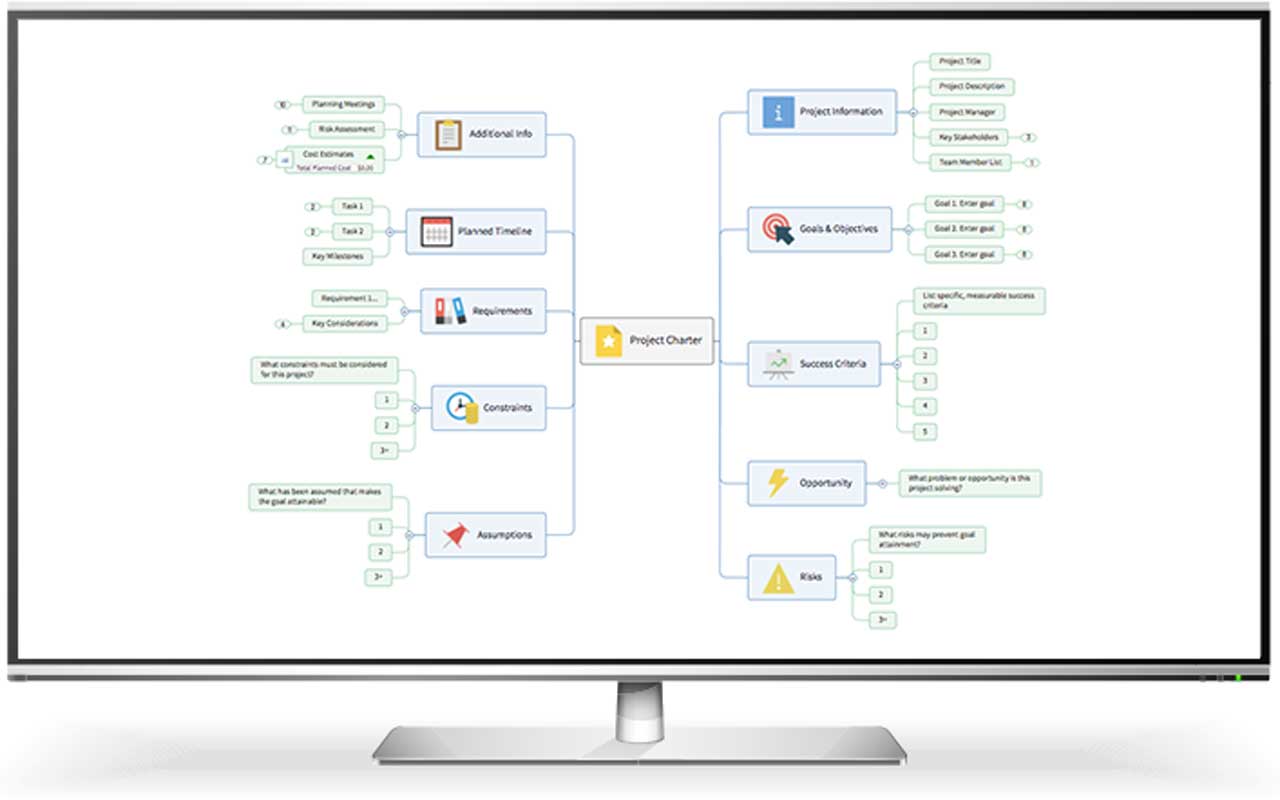
Source: MindManager
2. XMind: This mind mapping tool has a simple interface and is mainly for enterprise-level users . It lets you convert your mind maps to a Gantt chart that shows the start and end dates and progress of each task.
You can even use a countdown timer to time your sessions on this mind mapping software (this will keep you focused and will stop you from spending too much time mind mapping and brainstorming).
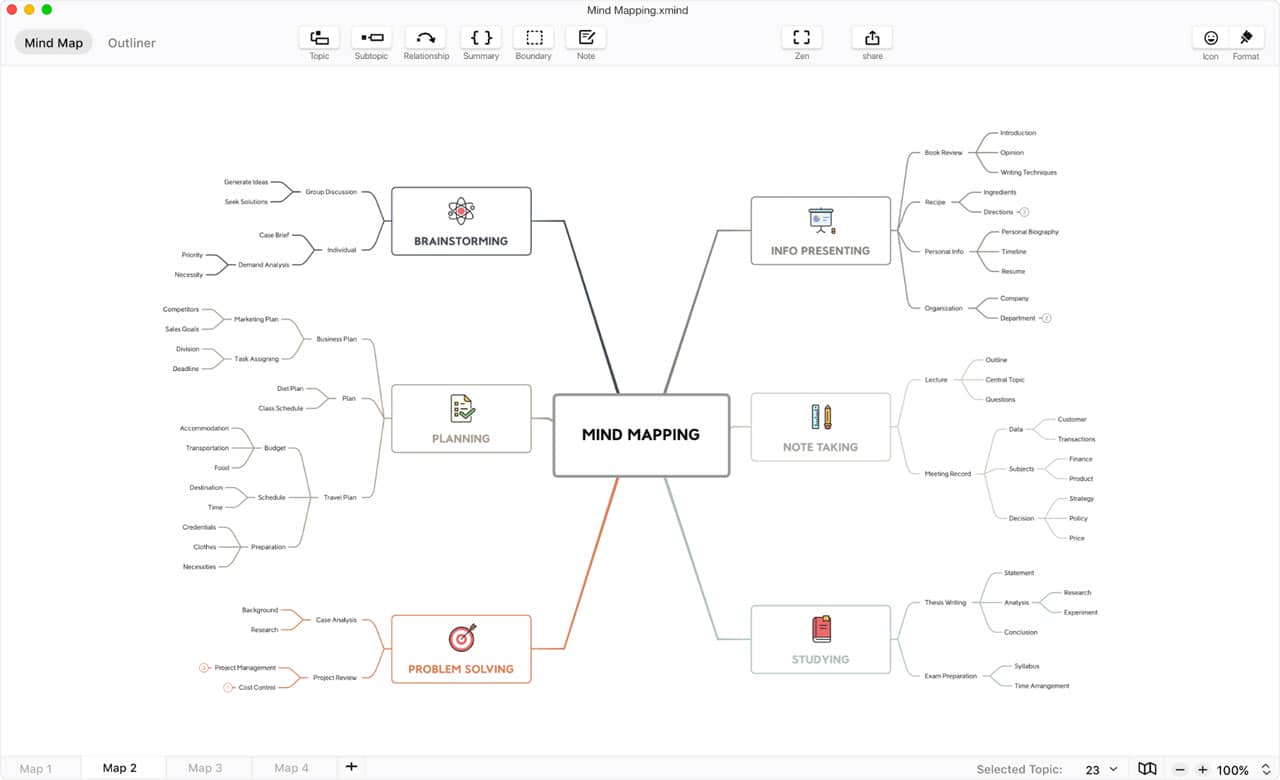
Source: XMind
3. Scapple: This mind mapping tool was built for writers by a writers group called “Literature and Latte.” It is easy to use and comes with great features (minus embedding audio and video).
With this mind mapping application, you’re not limited to starting with a central theme. You can begin with a small idea, then work backward to reach the main idea.
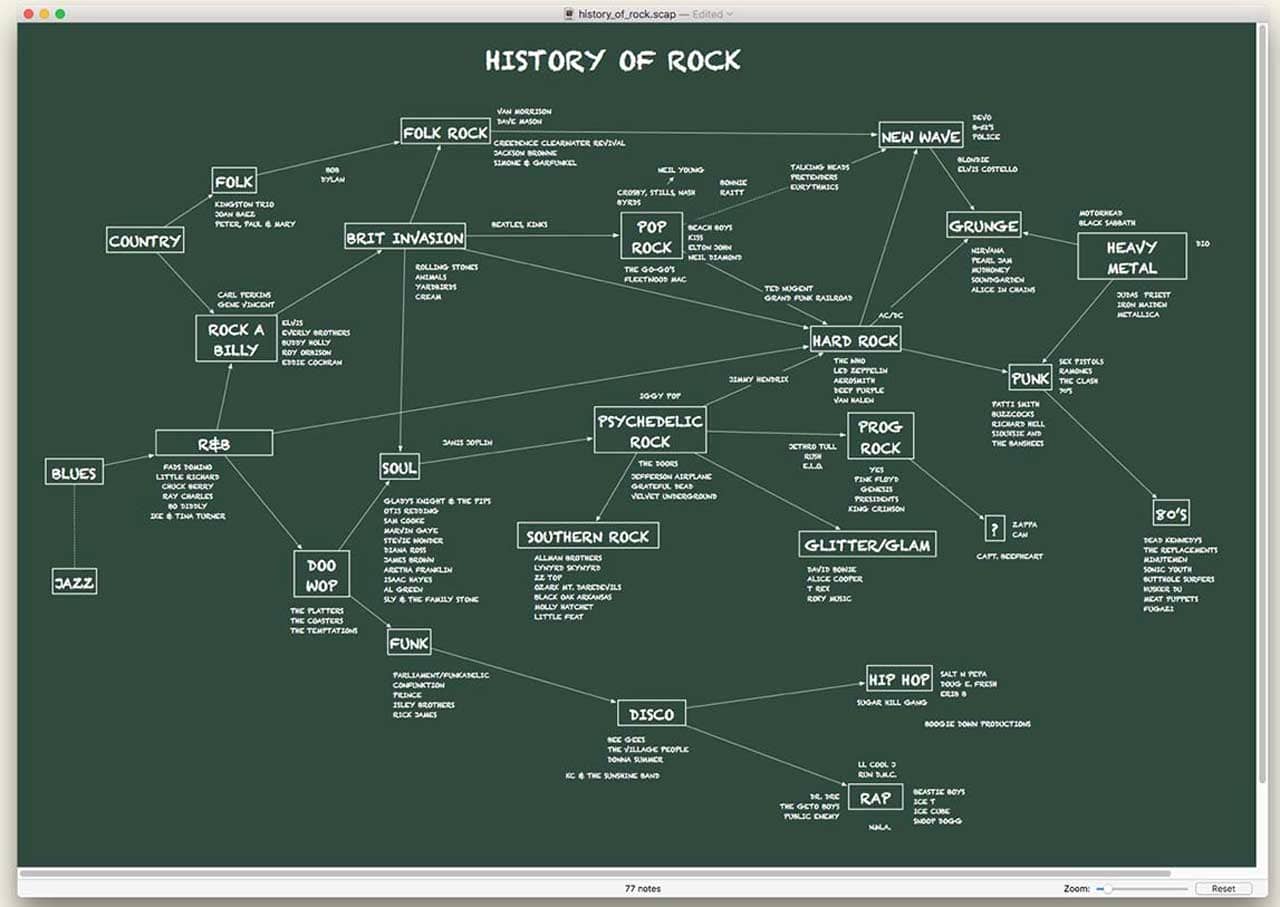
Source: Scapple
You could also experiment with an open-source free mind mapping tool like FreeMind or Coggle .
The point is this: there are a lot of options. For an example of one teacher who uses software and teaches with a specific focus on personal develop is Joseph Rodrigues. Here’s one of his best:
Mind Map + Memory Palace = Magnetic Memory
A mind map is an excellent non-linear visual representation of your ideas that mimics the way your brain thinks. You can also use mind mapping for business to help you determine how the market thinks too.
Once you master it (whether you use a notebook or a mind mapping software), you’ll never go back to linear note-taking ever again. But, mind mapping alone may not boost your brainpower as much as when combined with the Magnetic Memory Method. If you need more mind map examples , we have plenty.
Ready to use this combination to fire up your memory, creativity, and learning? Sign up for my free memory improvement kit today!

Related Posts
Mind mapping improves memory and creativity. These mind mapping examples for using the method of…
You want to expand your mind but don't know how. These 15 secrets show you…
It's possible to increase your IQ. The best part is that it's easy to do…
Last modified: March 5, 2024
About the Author / Anthony Metivier
2 Responses to " What is Mind-Mapping? The Ultimate Guide to Using This Powerful Tool "
Yesssss! Mind mapping has been KEY to getting my latest writing project off the ground. Thank so much for this guide! ❤️
That’s great, Deb.
Just about every one of my book projects have also involved mind mapping. I’ve got another one that just left the first draft stage, in fact. I sometimes use additional mind maps to work out the second drafts as well.
Leave a Reply Cancel reply
Your email address will not be published. Required fields are marked *
Save my name, email, and website in this browser for the next time I comment.
I accept the Privacy Policy
POPULAR POSTS
- How to Remember Things: 18 Proven Memory Techniques
- How to Build a Memory Palace: Proven Memory Palace Technique Approach
- How to Learn a New Language Fast: A Step-by-Step Guide
- Digital Amnesia: 5 Ways To Stop The Internet From Ruining Your Memory
- 15 Brain Exercises & Memory Exercises For Rapid Remembering
- The Memory Palace of Matteo Ricci
- Effortless Conference Interpreting: 7 Career-Making Memory Tips
- How To Teach Your Kids Memory Techniques
- 5 Unconventional, But Proven Note Taking Techniques

Recent Posts
- Do Brain Games Work? Here’s A Better Way To Fix Your Memory
- How To Prepare For A Debate: 8 Ways To Win & Build Reputation
- 3 Polymath Personality Traits Masterful People Nurture & Amplify
- Lifelong Learning: The Benefits in Life and in Today’s Job Market
- How To Stop Losing Things: 6 Proven Tips
Pay with Confidence

Memory Courses
- The Magnetic Memory Method Masterclass
- The Magnetic Memory Method Masterplan
- How To Learn And Memorize The Vocabulary Of Any Language
- How To Learn And Memorize Poetry
- How To Memorize Names and Faces
- How to Memorize Math, Numbers, Simple Arithmetic and Equations
- How to Remember Your Dreams
Quick Links
- Testimonials
- Privacy Policy
- Privacy Tools
- Terms of Service
P.O. Box 933 Mooloolaba, QLD 4557 Australia
Memory Improvement Blog
- How to Build A Memory Palace
- Eidetic Memory
- Episodic Memory
- Photographic Memory
- Improve Memory for Studying
- Memorization Techniques
- How to Memorize Things Fast
- Brain Exercises

- The Magnetic Memory Method Podcast
- Memory Improvement Resources for Learning And Remembering

COOL MEMORY TECHNIQUES!

GET YOUR FREE 4-PART VIDEO MINI-COURSE
Improve your memory in record time! Just enter your email below now to subscribe.
- How to learn anything at lightning fast speeds
- Improve your short and long term memory almost overnight
- Learn any language with and recall any information with ease
An official website of the United States government
The .gov means it’s official. Federal government websites often end in .gov or .mil. Before sharing sensitive information, make sure you’re on a federal government site.
The site is secure. The https:// ensures that you are connecting to the official website and that any information you provide is encrypted and transmitted securely.
- Publications
- Account settings
Preview improvements coming to the PMC website in October 2024. Learn More or Try it out now .
- Advanced Search
- Journal List
- BMC Med Educ

The effect of implementing mind maps for online learning and assessment on students during COVID-19 pandemic: a cross sectional study
Amany a. alsuraihi.
Physics Department, Faculty of Science, King Abdulaziz University, Jeddah, 21589 Saudi Arabia
Associated Data
The datasets used and/or analyzed during the current study are available as additional files.
In Saudi Arabia, the sudden shift from conventional (in-person) to online education due to the coronavirus disease 2019 (COVID-19) pandemic affected teaching and assessment methods. This research aimed to assess the effectiveness of mind maps in this regard, measure students’ reactions to certain educational environment-related changes caused by the pandemic, and identify skills that students perceived they gained through mind mapping.
This study employed a non-intervention (cross sectional) design. Participants were King Abdulaziz University students from two medical physics courses (second and fourth level). Data were collected twice (after the first and last mind mapping assignments), and responses were analyzed using a paired t-test. Overall student results were compared against overall student performance in the previous term using chi-squares test hypothesis testing. The data were collected and analyzed using SPSS software.
The results of the paired t-test showed no significant differences between students’ mean satisfaction in both surveys. Nevertheless, students’ responses revealed their satisfaction with using mind maps. Moreover, students believed that they gained skills like organizing and planning, decision making, and critical thinking from the mind map assignments. The chi-squares test (Chi-square = 4.29 < x 0.05 , 4 2 = 9.48 and p -value = 0.36 > 0.05) showed no differences in students’ grade distribution between the two terms of 2020 (pre- and post-COVID-19 pandemic) despite the change in assessment style post-pandemic commencement.
Conclusions
Mind mapping can be adapted as an online teaching and assessment method. Additionally, student support and education institution-level effective communication can reduce stress during challenging times.
Supplementary Information
The online version contains supplementary material available at 10.1186/s12909-022-03211-2.
On January 7, 2020, coronavirus disease 2019 (COVID-19) was identified as the cause of a cluster of pneumonia cases in Wuhan, China [ 1 ]. Since then, millions of people globally have been infected with COVID-19, and many families have been affected. To protect against the rapid spread of the virus, the World Health Organization recommends that people should maintain social distancing, wear masks, and practice good hygiene at all times. On March 8, 2020, following these recommendations, the government of Saudi Arabia closed educational institutions, including universities and schools at all levels, to control the spread of COVID-19 and protect the population. Hence, to maintain the safety of students and school staff while continuing to provide education, the Saudi Ministry of Education [ 2 ] made a sudden switch from conventional in-person education to virtual online education via different platforms. For instance, King Abdulaziz University began using the Blackboard platform. Support including workshops, necessary learning materials, and helplines were provided to ensure a smooth transition. However, many exams and quizzes were cancelled, and lecturers were directed to assess students' progress using other methods.
In the education field, and specifically in medical education, many learning strategies and tools have been designed to enhance students’ learning experiences, such as case-based teaching [ 3 ], role playing [ 4 ], problem-based learning, discussion groups [ 5 ], didactic learning [ 6 ], concept maps [ 7 ], and mind maps [ 8 ]. Both concept maps and mind maps are excellent learning tools to enhance students’ abilities to formulate concepts, analyze data, as well as connect ideas and understand the relationships between them. They both involve visual knowledge reconstruction, are easier to follow and engage with than verbal and written scripts, and provide an interactive learning method for students. However, they have certain differences. Concept mapping has a top-down structure that begins with the main concept/idea and branches out into sub-concepts/ideas, which are enclosed in circles or boxes. Association phrases and arrows are used to demonstrate the relationship between them. The structure could be hierarchical, non-hierarchical or data-driven. Some of the drawbacks of using concept maps are their limited extensibility, low memorability due to the level complexity of certain concepts, and the medium to high level of difficulty, as it requires expertise and training to master concept maps [ 9 , 10 ].However, mind maps are easier to grasp, encourage creativity, enhance engagement, promote ownership of ideas, and involve both brain hemisphere [ 9 ]. While Eppler’s study [ 9 ] shows that combining more than one visual mapping method can be of more benefit than using individual techniques, Martin Davies [ 10 ], who studied both concept maps and mind maps, claims that the choice of mapping technique depends predominantly on the aim and purpose of its use. Therefore, in the present study, mind mapping was chosen as an online learning and group assessment tool in two medical physics courses during the sudden changes brought about by the pandemic. This occurred approximately during the mid-second term, Spring 2020.
Literature Review
The mind mapping technique was developed by Buzan [ 11 ], based on a theory inspired by da Vinci’s notes, and by scientists such as Galileo, Feynman, and Einstein. A mind map starts with the main topic represented as an image at the center of the page, then the subtopics branch out and are placed onto curved lines. A keyword or image is included on each branch to represent ideas. These ideas continue to branch out as far as is required by the subject. Furthermore, connection lines, codes, and symbols are used to connect ideas, highlight important concepts, and stimulate creative thinking [ 11 , 12 ]. Many studies have explored the benefits of Buzan’s technique for teaching and learning, such as retaining information, organizing thoughts, and developing critical-thinking skills (e.g., reasoning, decision-making, and problem-solving) [ 11 , 12 ]. In a study conducted with elementary school teachers [ 13 ], teachers agreed that using mind maps in education would stimulate students’ creativity, enhance learning and memorization, and serve as a tool to assess students’ degree of comprehension for the topics being taught. Moreover, Ellozy and Mostafa [ 14 ] studied the feasibility of using a hybrid concept comprising mind mapping strategies among first-year students at the American University in Cairo and found that their technique enhanced students’ critical-thinking and reading comprehension skills, ability to engage in visualization, and imagination during learning and communicating ideas. Further, it was useful as an assessment tool for teachers to evaluate students’ systematic thinking [ 14 ]. Wu and Wu [ 15 ] showed that using mind mapping in medical education improved nursing students’ critical-thinking abilities and stimulated their eagerness to learn during their internship. This supported the findings of a previous study [ 8 ] that investigated the effectiveness of mind mapping as an active educational tool in a Nursing Management course to enhance students’ critical-thinking skills; the students’ scores were found to have improved. Mind maps were named as a factor contributing to the high-achieving medical students’ educational success [ 16 ]. Mind maps have also been used to enhance health education of patients and improve psychological well-being in cancer patients [ 17 ]. Chen [ 17 ] developed a mind map-based life review program (MBLRP), which is conducted through several sessions for the life review aspect (from childhood to adulthood, their cancer experience, and then a summary session of the life experience). Sessions use mind maps, videos and photos. Results show that the MBLRP is a promising intervention to promote psychological wellbeing among patients, while being enjoyable, feasible, and easily accepted. Another study done by Tan et al. [ 18 ] concluded that mind mapping can improve the effectiveness of health education and guidance for patients with lung cancer who were undergoing chemotherapy, where the level of perceived control improved symptom distress; the longer the period of health education, the better the effect. Yang et al. [ 19 ] investigated the effectiveness of using mind mapping as a health education tool for children with cavities who were in extended care, as well as their parents. The results show an increase in child and parent compliance with health education, which is evident from an increase in cavity knowledge and more follow-up visits to the dentist. Mind map have also proven effective as a language learning material for students; for example, Petrova and Kazarova [ 20 ] discussed the feasibility of using mind maps as a teaching and learning tool in foreign language acquisition, as it helps students to be independent learners and solve diverse problems. Kalizhanova et al. [ 21 ] created a trilingual e-dictionary using a mind map program for high school students, to teach them biological terms in Kazakhstan. Furthermore, Alahmadi’s [ 22 ] study showed a significant improvement in vocabulary acquisition by students who used mind maps as a learning strategy for English language vocabulary as a second language. Mind maps were also used in science and engineering as educational material, learning exercises, and a critical thinking tool for collaborative and independent learning. Gagic et al. [ 23 ] used mind maps to teach physics to primary school students; results showed an increase in student achievement and a decrease in the mental effort necessary to study physics, when compared to conventional teaching and learning methods. In the teacher education program for mathematics, Araujo and Gadanidis [ 24 ] have developed a theory to promote mathematical and pedological knowledge construction by applying an online collaborative mind mapping exercise to two educational courses: computational thinking in mathematics education and mathematics teaching methods. In a study conducted by Allen et al. [ 25 ], mind maps were used in flipped learning activities in a chemistry lab, which included students with special needs. Students were reflective on their learning, collaborative with their peers, and engaged with each other during the activity. This enhanced their critical thinking, deepened their knowledge, and strengthened their interpersonal skills. In the field of engineering, Lai and Lee [ 26 ] show that mathematical engineering students’ achievement levels increased by using mind maps, while their cognitive load reduced. Hence, using effective learning and teaching techniques like mind maps reduces students' cognitive load. Chen et al. [ 27 ] have studied the collaborative behavior of engineering students while doing brainstorming activities using mind maps. Their study analyzed the change in students’ behavior during mind map tasks and issues that arose to implement in the design of digital mind map tools. Selvi and Chandramohan [ 28 ] have used mind mapping technique in collaborative tasks for a mechanical engineering course, which increased students' academic achievement and motivation to learn. Here, using mind maps in collaborative and interactive learning settings enhanced students’ ability to recall technical terms. To the author’s knowledge, mind maps have not yet been investigated in a medical physics course. However, previous studies done on mind maps for medical, science, and engineering courses showed that they are on the same level as medical physics courses in terms of their cognitive load. Hence, it should be a suitable learning and assessment tool during the pandemic. Therefore, this study aims to assess the effectiveness of mind mapping as a learning and assessment tool for medical physics students, while under stress from the COVID-19 pandemic and while experiencing the related educational mode changes. Accordingly, the following were assessed:
- Student satisfaction with the provided information on mind mapping and associated course assignments.
- Effects of changing the assessment style due to switching from on campus to online classes in relation to students’ satisfaction.
- Student satisfaction with using mind maps as a learning tool and student perceptions of the skills gained from the assignment.
To evaluate these objectives, this study developed two online surveys (Surveys 1 and 2) It hypothesized that students could improve satisfaction by practicing mind maps and that academic achievement would be unaffected by the pandemic compared to previous pre-pandemic commencement results. This study could set the basis for future studies when adapting mind maps as an online learning and assessment method and presenting a measure for students’ satisfaction and perception on the technique.
During the online teaching period from March through the end of April 2020, three mind map assignments, one set of critique questions, and two surveys were given to students in two different courses as an alternative teaching and assessment method. These three assignments covered important topics in both courses, as the grading system was changed by the Ministry of Education due to the COVID-19 pandemic. Therefore, mind mapping assignments were chosen as an alternative, to enhance students’ learning and memorizing and for use as an assessment tool. Performing this assignment as part of a group in such sudden and stressful circumstances could help students acquire soft skills, such as conflict resolution and time management. Moreover, results of total students’ achievement in these courses in the second term were compared with students’ achievement level in the first term of 2020, prior to the COVID-19 outbreak, using hypothesis testing.
The sample chosen for the study was the cluster sampling from the Kingdom of Saudi Arabia, Jeddah City, King Abdulaziz University, Department of Physics, Female Campus. Participants were medical physics students. The sample includes only female students, as the female and male campuses are separated at Saudi Arabian Universities. The study was conducted with female students enrolled in two separate medical physics courses taught by the author of the study: 1) health physics, a second-level introductory course, and 2) magnetic resonance and medical imaging (MRI), taught to fourth-year students. The sample of the study was 55 students in total, from both courses. Students were verbally informed that 1) survey participation would be voluntary, 2) responses would be anonymous, and 3) non-participation would not affect their course grades, as no identifying information would be collected. Thus, participation was considered to imply consent.
Assignments
To perform the mind mapping assignments, students were first assigned randomly to groups of 3–6 students using the Blackboard system. There were 11 students in the MRI course; thus, students were divided into 3 groups. There were two classes for the health physics course, one with 14 students and one with 30 students, who were divided into 3 and 5 groups, respectively. Thus, 55 students in total were given three mind map assignments that covered the most important course topics. Each mind map covered a section of the course that students had already completed.
All mind mapping assignments were posted on Blackboard with instructions for guidance. Students also participated in a short session in which the assignments were explained, with an emphasis on the resources provided to assist them and the grading style (rubric). Students were directed to engage in self-learning on the Blackboard platform by using the different posted YouTube video instructions and resources in Arabic and English on how to create a mind map. Students were also given the freedom to choose and download one of the three online mind mapping software apps: MindMaster [ 29 ], MindMeister [ 30 ], and XMind [ 31 ]. Online materials on how to use each tool were also posted for students on Blackboard.
Based on concept map assessment criteria published online, the author designed a mind map rubric to assess students’ accomplishments (see Appendix A in Additional File 1 ; [ 32 , 33 ]). After each mind mapping assignment, students received feedback on their work on Blackboard based on the rubric.
After these assignments were completed, a fourth assignment was posted for students on Blackboard. This assignment included mind maps that the students had worked on in each course: 23 for the health physics course, 8 for the MRI course, and a set of 3 questions. The mind maps with the highest scores were excluded from this assignment. Students were directed to choose a mind map that they did not work on and answer the three critique questions. The questions were as follows: “Does this mind map include all ideas and concepts related to the subject? If not, state what is missing? State only one aspect that is missing;” “What are the aspects that you like most about the mind map (e.g., in terms of ideas, links and connections used, supporting evidence, information used);” and “Provide at least one suggestion to improve this mind map.” The motivation behind this assignment was to encourage students to constructively critique their peers’ work. Therefore, there were no wrong answers to 2 out of the 3 questions, unless students failed to spot their peers’ mistakes regarding missing information on the mind map. The results of this assignment are not shown in this paper.
To address study objectives, a survey was distributed online to students in both courses after the first assignment (Survey 1), Appendix B in Additional File 1 . It was divided into three main sections: student satisfaction with the information regarding mind mapping and associated assignments; effects on students regarding the change in assessment style due to COVID-19 control measures and the transition to online education; and student satisfaction with using mind maps as a learning tool and the skills gained from the assignment. Responses to the questions in each section were rated on a five-point Likert scale ranging from “strongly agree” to “strongly disagree.” Additionally, an extra question on the skills students believed they acquired when working on their assignments was included.
After submitting the last assignment, the same survey was posted for students again with an extra open-ended question: “After finishing all three mind mapping assignments, what do you think are the positive and negative aspects of the assignments?” “Do you have any suggestions about them?” (Survey 2). This was done to compare students’ responses from both surveys and measure changes in their perceptions regarding mind mapping through their openly shared views on the assignments.
Statistical analysis
To address the research questions, students were asked to complete a survey after the first assignment and again after the last. The data collected from students for first survey S1 is available in Additional file 2 while the data collected from the second survey S2 is available in Additional file 3 . Students’ responses to the two surveys were then compared, as were their achievement levels in the first term before the COVID-19 pandemic and the second term after the pandemic began. The data for students’ academic achievement in first and second term can be found in Additional file 4 . Both Survey 1 (S1; N = 53 students) and Survey 2 (S2; N = 45 students) had one independent variable—medical physics students (health physics and MRI). However, the dependent variable for S1 represented students’ answers related to the survey’s objectives, while for S2, they represented students’ answers related to the survey’s objectives and to an open-ended question. To measure the internal consistency of the survey items, Cronbach’s Alpha was used. It creates a measure of reliability for the survey items and how closely related a set of items within a group are. Factor analysis was used to test the validity between the survey questions in subsites. If the value is less than the absolute value of 0.4, it is inconsistent and saturated. This analyses the relationships between the set of survey questions that are grouped per survey aim (subset), to determine whether the participant’s responses on different questions per survey aim (subsets) relate more closely to one another than to other survey questions [ 34 ].
Responses to positively worded questions were collected and coded as follows: strongly agree = 5, agree = 4, neutral = 3, disagree = 2, and strongly disagree = 1. However, to maintain consistency, for Questions 1 and 2 in the second section of the survey (Appendix B in Additional File 1 ), the negatively worded questions were taken into consideration, and responses to these were reverse coded. The survey data were analyzed using the SPSS software package. Frequencies (N), percentages (%), means (M), and standard deviations (SD) were used to analyze the response. Responses to the open-ended question from S2 were low (only 19 response) and hence not statistically significant. Therefore, the coding technique was used, and similar answers were added into the same category. Answers were categorized as positive, negative, and in the form of suggestions for mind mapping assignments.
The means of both surveys' first and second objectives were tested for their significance of difference using a paired samples t-test. Finally, a chi-squared test was used to determine any statistically significant differences between student achievement levels in the first term (pre-COVID-19 pandemic) and the second term (post-COVID-19 pandemic commencement).
Responses from the questionnaires of S1 and S2—which were provided prior to the final exams after students submitted all assignments and were given feedback on their work and scores based on the rubric—were analyzed. Cronbach’s alpha was 0.829 and 0.775 for S1 and S2, respectively, indicating a relatively high internal consistency for both surveys. Table Table1 1 show the result of factor analysis for both surveys S1 and S2. Results show good internal validity values, except for Question 6 in S1, while showing good internal validity for S2. This could be due to the sample size, as the larger the sample size, the better the statistical power, which reflects on factor analysis values [ 34 ]. As shown in Table Table2, 2 , the highest responses for S1 and S2 were from the health physics course, which made up 81% and 80% of the responses, respectively. The remaining 19% and 20% responses in S1 and S2, respectively, were from the MRI course students. This similarity in results was expected, as more students were registered for the health physics course.
Factor analysis with principle component analysis for Survey 1 and 2
Number of responses in survey 1 and 2
S1: Survey 1, S2: Survey 2, MRI – JAR: Magnetic Resonance and Medical imaging course, course code: JAR, HP: Health Physics Course, course’s codes: GAR and IAR
Table Table3 3 provides detailed information on the mean, standard deviation, and trend for responses to each question regarding student satisfaction with the information provided to them about mind mapping and the associated course assignments in S1 and S2. The overall mean frequency for responses in S1 and S2 was 3.38 and 3.53, with a trend of “neutral” and “agree” responses, respectively. Thus, students indicated overall satisfaction with the information provided about mind mapping and the associated course assignments in S2. Additionally, S2 results showed that 60% of students had not been previously trained on mind mapping (Q1), while 26.7% of students had used mind maps in their studies before. Regarding the usefulness of the supporting information provided (Q2) and recommended instructional videos (Q3), 66.7% and 57.8% of students found this to be useful, respectively, while only approximately 4% and 18% did not, respectively. Most students (73.4%) agreed that the assessment method (rubric) the instructor provided was clear (Q4), while 13.4% did not understand the assessment method.
Student satisfaction with information provided about mind mapping and assignments
S1: Survey 1; S2: Survey 2
Table Table4 4 provides detailed information on the responses to each question regarding the effects of changing the assessment style due to COVID-19 control measures and switching from on-campus classes to online virtual classes and students’ satisfaction levels. S1 and S2 results show a mean score of 3.06 and 2.98, respectively, indicating a generally neutral response.
The effect of changing assessment styles due to COVID-19 spread control measures and the transition to online education on students’ satisfaction
* To maintain consistency with analysis as reverse coding in Likert scale for Q1, Q2 was used with negative wording ("not stressful" here). S1: Survey 1; S2: Survey 2
As shown in Table Table5, 5 , student satisfaction with using mind maps as a learning tool and the skills they gained from the assignments had a mean frequency of 3.75 and 3.56 in S1 and S2, respectively, with a general trend of “agree” responses; this reflects a consensus among students regarding their satisfaction with using mind maps as a learning tool. In S1 and S2, approximately 64% and 53.4% of the students agreed that using mind maps was beneficial to their learning in and understanding, while only 15% and 9% believed it was not, respectively (Q1). Furthermore, 69% of students agreed that working on the mind maps helped them recognize and identify themes in the lectures, while 9% did not in both S1 and S2 (Q2). In addition, when students were asked if using mind maps helped them gain a deeper understanding of the subject they were studying, 59% in S1 and 58% in S2 agreed that it was beneficial to them, while 21% in S1 and 18% in S2 did not find it useful (Q3). Regarding working on the mind mapping assignment in groups, 51% and 42% of students agreed they had gained new skills, compared to 26% and 31% who were not satisfied with their group in S1 and S2, respectively (Q4). However, when students were asked if they would continue using mind maps in their studies in S1 and S2, 68% and 60% stated they would, while only 19% and 16% reported they would not, respectively (Q5).
Students’ satisfaction with using mind maps as a learning tool
Figure 1 summarize students’ responses in S1 and S2, regarding the skills they perceived themselves as gaining by participating in the mind mapping assignments. Student responses in both surveys suggested that the top skill gained was organizing and planning (S1: 30%; S2: 27%), followed by decision-making skills (S1: 18%; S2: 22%). However, in S1, the proportions of students who gained problem-solving (13%) and persuasion and influencing skills (12%) were almost equal, followed by 11% of students gaining critical thinking skills. Conversely, in S2, nearly an equal proportion of students perceived gaining critical-thinking (14%) and problem-solving (13%), followed by 9% of students gaining persuasion and influencing skills. Finally, student responses in both surveys reported that conflict-resolution (S1: 9%; S2: 8%) and feedback (S1: 7%; S2: 7%) skills were gained the least.

Bar chart representing students’ perceptions in Survey 1 and 2 regarding each skill gained during their group work on the mind mapping assignment
In the open-ended question added to S2, students reported the following responses regarding the assignments: 1) positive aspects: they learned new skills, better understood the course, learned in groups, and gained independent learning skills while studying; 2) negatives aspects: shorter submission deadlines, difficulty in group-work for some students, and challenges in identifying key concepts; 3) improvements suggested: allowing students to choose their group members and providing a practice session for students before the first assignment is posted on Blackboard. Figure 2 shows the improvements in students’ results across all three mind maps.

Improvements in students’ average scores out of 12 in both courses with each assignment
Students’ satisfaction with mind map assignments and comparison of students’ academic achievement in the current (after COVID-19 pandemic started) and previous term (before COVID-19 pandemic)
The paired samples t-test showed no significant difference between students’ mean satisfaction in S1 and S2. This indicated a lack of post-S2 improvement in students’ satisfaction. For the first objective, a paired samples t-test was performed on students’ average satisfaction in S1 (M = 3.38, SD = 0.85) and S2 (M = 3.53, SD = 0.81), with information regarding mind mapping and associated course assignments. However, no significant differences were found in students’ satisfaction. For the second objective, students’ average responses regarding the effect of changing assessment styles and the transition to online education on students’ satisfaction were compared between S1 ( M = 3.06 , SD = 0.92) and S2 (M = 2.98 , SD = 0.95 ) S2, and the results indicated no significant differences in students’ satisfaction for this objective. Similarly, no significant differences were found for the third objective, between students’ responses regarding satisfaction with using mind maps in S1 ( M = 3.74 , SD = 0.95) and S2 ( M = 3.56 , SD = 0.77 ) .
Figure 3 shows a normal distribution for students’ grades in the first and second semesters in both the health physics and MRI courses. The result of a chi-squares test shows that there are no differences in students’ grade distribution between the two term of year 2020, before and after COVID-19 pandemic started. Hence, chi-square = 4.29 < x 0.05 , 4 2 = 9.48 and p-value = 0.36 > 0.05 support hypothesis H 0 , where H 0 means no relationship between students’ academic achievement and term, where grades are independent of the term, while H 1 posits there is a relationship between student academic achievement and term, where grades are dependent on the term.

Grade distribution for students in the two courses during the first and second terms in the academic year 2019–2020
This study investigated the use of mind maps as a learning and assessment tool for medical physics students at KAU under the stress of the COVID-19 pandemic and a sudden switch in teaching mode from on-campus to online classes. Two surveys, one directly after the first mind map assignment and the other just before the final exam, were distributed to students, to assess student satisfaction with the information provided on mind mapping and the associated course assignments, effects of changing assessment styles due to COVID-19 control measures, switching from on-campus classes to online classes, student satisfaction levels, student satisfaction with using mind maps as a learning tool, and the skills gained from the assignments.
The findings showed no significant differences between surveys for students' mean satisfaction scores. This could be due to the sudden changes and control measures that were implemented by the Ministry of Education during the COVID-19 pandemic, as explained above; hence, the study was conducted over a short period, during the second half of the second term of 2020. Moreover, most students had no prior experience with mind maps, and only 19% of the students who conducted the survey (survey S1) said that they learnt and used mind maps before this course. Furthermore, the study was conducted with a limited number of students. However, by comparing the results of students’ responses to each of the surveys’ objectives, we were able to gain a deeper insight. Hence, although students were not initially certain about the usefulness of the information provided, as they completed more assignments, they became more skilled in using mind maps and could make clearer judgments. This confirms that the mind map is a powerful tool that can be easily adapted when suitable guidance is provided, and results can be seen over a short period of time. This is in line with the findings of previous studies [ 15 , 35 ], which compared memory retrieval and critical-thinking in medical students using mind mapping and standard note-taking techniques. Although there were no differences in the results between the two methods, students did not use mind mapping before participating in the study, which indicates that mind mapping is a robust learning technique.
The mean response was neutral in both surveys regarding the effects of changing assessment styles due to COVID-19 control measures, switching from on-campus to online classes and student satisfaction levels. Students were unable to decide if they agreed or disagreed that the sudden changes were stressful. Moawad [ 36 ] studied student responses to academic stress from online learning during the COVID-19 pandemic. The study found that the main source of stress stemmed from uncertainty about exams and assignment changes. These issues were addressed at our university almost immediately after switching to online teaching platforms; there was tremendous support and prompt strategies and polices were provided in response to the pandemic to maintain effective education for students. Student support included short online courses on how to use Blackboard, support for students with special needs, and online academic and psychological counseling, with reassuring messages provided to students on university social media platforms [ 37 ].
In both surveys, students were satisfied with the use of mind mapping as a learning tool. This finding confirms that it is an effective learning tool that can improve students’ comprehension and information retrieval skills in medical education [ 5 , 15 ], enhance learning and vocabulary recall [ 38 ], and improve writing in English [ 22 ]. Colors, images, and connections are all used in the learning process, which in turn increase students’ motivation to learn [ 39 – 41 ]. Moreover, students’ responses to the open-ended questions in both surveys regarding skills they perceived themselves as acquiring during group work on the mind mapping assignments showed that organizing, planning, and decision-making skills were acquired most frequently, while critical-thinking skills came in third. All these skills are crucial for students’ academic achievement. Abdulghani et al. [ 16 ] reported that high-achieving medical students perceived prioritization, time management, and mind mapping as factors that contributed to their academic success. Furthermore, the present study shows that the more the students complete mind map assignments, the more improvement there is in their grades for mind maps. This indicates that continuous application of the mind mapping technique can improve students’ learning, which is reflected in their grades and achievements. Students’ perceptions of the advantages of using mind maps, such as enhanced learning and comprehension, were similar to the results of previous studies by Wickramasinghe et al. [ 41 ], Erdem [ 42 ], and Wu and Wu [ 15 ].
However, some students thought that mind mapping was time consuming and felt that they needed more time, while others thought that identifying the main concept was challenging and there were concerns regarding low grades. These concerns were examined by Erdem [ 42 ] in a study focused on university students’ perceptions on the use of mind mapping as a lifelong learning tool, which suggested that as students continue to develop mind maps, they become faster and more skilled, creative, and imaginative. Some students thought that working with mind maps in a group was an opportunity to learn, while others thought it was a disadvantage. While Stokhof et al. [ 40 ] concluded that shared mind map activity enhances students’ learning and critical thinking, Jones et al. [ 39 ] suggested varying students’ mind mapping activities and allowed students to work on mind maps according to their preferences—individually in or out of class or with groups—could maximize student engagement, thereby improving their learning goals.
Despite the circumstances of the second term in which the COVID-19 pandemic began and education and lifestyle changes were enforced as preventive measures, there are no significant differences in students’ grade distributions between the two terms of the year 2020 (before and after the COVID-19 pandemic began). This is in alignment with a study done by Elsaid [ 43 ], whose results showed no significant difference despite this sudden switch. The study also compared students’ grade distribution for the two-learning models in the developing country, taken before the pandemic (face-to-face learning model) and after the COVID-19 pandemic (online learning model). This is also confirmed by studies comparing the performance of online learners with conventional (face-to-face) learners before the pandemic started [ 44 , 45 ]. Moreover, another study by Gonzalez et al. [ 46 ] conducted on Spanish university students showed a significant improvement in students’ performance during the COVID-19 pandemic, despite the teaching model changes. The students believed to be motivated to change their time management habits during studying and learning strategies and improving their independent learning performance to adapt to the uncertainties that came with the pandemic, thus ensuring that their academic advances which back as an improvement in their performances. However, conflicting outcomes were reported in other studies. This is evident in a recent study done by Giusti [ 47 ] on Italian students’ perspectives regarding distance learning and its impact on their psychological health and academic performance. The study showed that the negative impact of online education on students is related to psychological factors, such as anxiety and depression. This is due to lack of social interaction, technical, and economic factors. This in turn reflects negatively on students’ performance. The lack of network availability, suitable network coverage and educational platforms, online educational support from courses’ instructors, virtual interaction with colleagues and instructors, efficient online course content, online support and training on the provided online platforms, and financial support for students are also key factors that are reported to affect students’ performance [ 48 , 49 ]. Adapting a strategic and swift switch to online education could mitigate the dramatic effect that could arise because of sudden and extreme situations, such as the COVID-19 pandemic. For example, to sustain educational support for students, King Abdulaziz University KAU managed to successfully implement an online model where thousands of classes were conducted weekly with the help and support of the Deanship of e-Learning and Distance Education. As a result, AI-Youbi et al. [ 37 ] proposed the KAU Pandemic Framework that integrates five pillars of strategic adoption of the social media platform (Twitter): social media governance, social media resilience, social media utilization, decision-making capabilities, and institutional strategies, which help provide flexible and sustainable education and learning overtime. Twitter was used throughout the pandemic time to communicate with the KAU community regarding administrative issues, educational sustainability, and community responsibility. Hence, KAU could communicate all regulations and changes due to the COVID-19 pandemic and at the same time, attend to students needs by providing helplines for student enquires, the supply of free laptops for students in need, online academic advice, psychological support, and online support for disabled students and students with autism. Furthermore, there were many activities organized for community support, such as raising awareness of COVID-19 and safety measures through workshops and infographics.
The study aimed to measure the effectiveness of mind mapping as a learning and assessment tool for female medical physics student during the pandemic. Hence, students’ satisfaction were also considered by conducting two surveys measuring: the learning material on mind maps and associated course assignments provided, changing the assessment style due to the sudden switch from face-to-face to online learning models, and using mind maps as a learning tool. Students were also asked about their overall experience and skills that they perceived to have gained from the mind map assignments. Although results show no significant difference between students’ mean satisfaction in both surveys, students’ responses showed consistency regarding their satisfaction with using mind maps. The results of the present study indicate that mind-mapping is a powerful learning tool that, if practiced and mastered by students, could enhance their learning outcomes and improve their critical-thinking and soft skills. However, our number of participants was limited. The sample only included two courses that were taught for second- and fourth-year female medical physics students of a Science faculty in KAU. Future studies could include a longitudinal analysis over a longer period. They should also include the effect of some learners’ demographic and academic variations, such as gender, age, degree, and GPA. It is worth expanding the study to include other courses for medical physics within the same institute, and expanding it to compare different subjects within the same faculty, thus improving the scope of the results. Moreover, future collaborative research across institutes could help assess regional differences.
The results also show that the sudden switch in educational settings, from conventional to online due the COVID-19 pandemic, didn’t negatively affect students’ grades. In challenging situations such as these, well-established communication between educational institutions and students is believed to ease students’ stress regarding the effects of changes on their grades and future. For future research, it might be worth involving students in a variety of mind mapping activities—individually in or out of class or with groups—to explore differences in their learning preferences and how this can affect learning experiences.
This study did present certain limitations. First, although students were given the option to choose software programs, some software had limited features, which could cost students money or time when they must learn a new software program. Therefore, to overcome this difficulty, it is recommended that students are provided with one software program that is supported by the educational institution. Second, although students were provided with materials and a short session to explain mind mapping, some students still reporting difficulties in understanding the technique. Thus, it is recommended that students are offered a practice session and a mock mind mapping assignment to ensure that they understand the process fully. To maximize students’ learning experience, it is also suggested that a discussion session be provided, where students can present their work to their peers in class and discuss their ideas and suggestions for improvements. Finally, this study was performed in a limited context; hence, it is recommended that this method be applied to future research using different courses and over a longer period to monitor changes in students’ achievements.
Acknowledgements
The author would like to thank Editage ( www.editage.com ) for English language editing.
Abbreviations
Authors' contributions.
The design of the work, collection, and interpretation of data were performed by the author of this manuscript.
Not applicable.
Availability of data and materials
Declarations.
This study was performed in line with the principles of the Declaration of Helsinki. Approval was granted by the affiliated Institutional Review Board (Unit of Biomedical Ethics and Research Committee; reference number: 645–20 [Non-intervention; cross-sectional]). The surveys used in this study were online surveys. Students who participated in these surveys were informed verbally that their responses would be anonymous and non-participation would not affect their grades. Hence, participation contained informed consent. The consent statement was as follows: "Dear students, survey participation is voluntary. Your responses will remain anonymous, and non-participation will not affect your course grades, as no identifying information will be collected. However, your participation will help improve the assignments and your opinion would be appreciated and taken into consideration."
The authors declare that they have no competing interests.
Publisher's Note
Springer Nature remains neutral with regard to jurisdictional claims in published maps and institutional affiliations.
Advertisement
Effects of mind mapping-based instruction on student cognitive learning outcomes: a meta-analysis
- Published: 04 March 2022
- Volume 24 , pages 303–317, ( 2023 )
Cite this article
- Yinghui Shi ORCID: orcid.org/0000-0003-4922-2870 1 ,
- Huiyun Yang 1 ,
- Yi Dou 2 &
- Yong Zeng 2
2448 Accesses
7 Citations
2 Altmetric
Explore all metrics
Mind mapping is a visualization tool used in instruction that can be applied by learners to generate ideas, take notes, organize thinking, and develop concepts. Instruction using mind mapping is becoming increasingly commonly used in education. However, research has produced inconsistent results regarding the effectiveness of mind mapping-based instruction on student learning outcomes. Using the meta-analysis of 21 studies, this study investigates the overall effectiveness of the mind mapping-based instructions on students’ learning outcomes in comparison with that of traditional instruction. Mind mapping-based instruction has been found to have a more positive influence on students’ cognitive learning outcomes than traditional instruction. Analysis of moderator variables suggests that the subject matter and educational level are important factors in the effectiveness of mind mapping-based instruction. Lower-grade students are more susceptible to the influence of mind mapping-based instruction than higher-grade students, and mind mapping-based instruction helps students improve their cognitive learning outcomes in all subjects, especially in the Science, Technology, Engineering, and Math disciplines.
This is a preview of subscription content, log in via an institution to check access.
Access this article
Price includes VAT (Russian Federation)
Instant access to the full article PDF.
Rent this article via DeepDyve
Institutional subscriptions
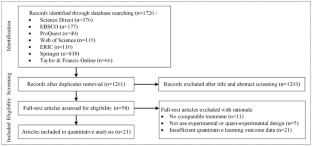
Similar content being viewed by others
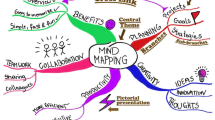
Exploring the psychometric properties of the mind-map scoring rubric
Cheng Hua & Stefanie A. Wind

Usefulness and Effectiveness of Mind Mapping: An Analysis of CTU101 and CTU151 Courses
Studying and constructing concept maps: a meta-analysis.
Noah L. Schroeder, John C. Nesbit, … Olusola O. Adesope
References marked with an asterisk indicate studies included in the meta-analysis
Abi-El-Mona, I., & Adb-El-Khalick, F. (2008). The influence of mind mapping on eighth graders’ science achievement. School Science and Mathematics, 108 (7), 298–312. https://doi.org/10.1111/j.1949-8594.2008.tb17843.x
Article Google Scholar
Adodo, S. O. (2013). Effect of mind-mapping as a self-regulated learning strategy on students’ achievement in basic science and technology. Mediterranean Journal of Social Sciences, 4 (6), 163–172. https://doi.org/10.5901/mjss.2013.v4n6p163
Al Hakim, S., Sensuse, D. I., & Budi, I. (2020). Conceptual model smart knowledge mapping with process and activity combination quadrant: Finalization and implementation. The Journal of High Technology Management Research, 31 (2), 100393. https://doi.org/10.1016/j.hitech.2020.100393
*Al-Zyoud, A. A., Al Jamal, D., & Baniabdelrahman, A. (2017). Mind mapping and students’ writing performance. Arab World English Journal, 8 (4), 280–291. https://doi.org/10.24093/awej/vol8no4.19
*Ayal, C. S., Kusuma, Y. S., Sabandar, J., & Dahlan, J. A. (2016). The enhancement of mathematical reasoning ability of junior high school students by applying mind mapping strategy. Journal of Education and Practice, 7 (25), 50–58.
Google Scholar
*Aydin, G. (2013). The effects of technology-supported mind and concept mapping on students’ construction of science concepts the effect of mind mapping in science education. Anthropologist, 20 (1–2), 166–176.
*Bahadori, A., & Gorjian, B. (2016). The role of mind mapping software in developing EFL learner’s vocabulary at the pre-intermediate level. Journal of Applied Linguistics and Language Learning, 2 (1), 8–16. https://doi.org/10.5923/j.jalll.20160201.02
*Balim, A. G. (2013). The effect of mind-mapping applications on upper primary students’ success and inquiry-learning skills in science and environment education. International Research in Geographical and Environmental Education, 22 (4), 337–352. https://doi.org/10.1080/10382046.2013.826543
Balta, N., Michinov, N., Balyimez, S., & Ayaz, M. F. (2017). A meta-analysis of the effect of peer instruction on learning gain: Identification of informational and cultural moderators. International Journal of Educational Research, 86 , 66–77. https://doi.org/10.1016/j.ijer.2017.08.009
Batdi, V. (2015). A meta-analysis study of mind mapping techniques and traditional learning methods. The Anthropologist, 20 (1–2), 62–68. https://doi.org/10.1080/09720073.2015.11891724
*Bawaneh, A. K. (2019). The effectiveness of using mind mapping on tenth grade students’ immediate achievement and retention of electric energy concepts. Journal of Turkish Science Education, 16 (1), 123–138. https://doi.org/10.12973/tused.10270a
Biktimirov, E. N., & Nilson, L. B. (2006). Show them the money: Using mind mapping in the introductory finance course. Journal of Financial Education, 32 , 72–86. https://doi.org/10.2307/41948535
Blessing, O. O., & Olufunke, B. T. (2015). Comparative effect of mastery learning and mind mapping approaches in improving secondary school students’ learning outcomes in physics. Science Journal of Education, 3 (4), 78–84. https://doi.org/10.11648/j.sjedu.20150304.12
Buzan, T., & Buzan, B. (1993). The mind map book: How to use radiant thinking to maximise your brain’s untapped potential . Plume.
*Chang, J. H., Chiu, P. S., & Huang, Y. M. (2018). A sharing mind map-oriented approach to enhance collaborative mobile learning with digital archiving systems. International Review of Research in Open and Distributed Learning, 19 (1), 1–24. https://doi.org/10.19173/irrodl.v19i1.3168
Cochrane Collaboration. (2014). Review manager (Version 5.3) [Computer software]. Retrieved from https://community.cochrane.org/help/tools-andsoftware/revman-5/revman-5-download
Crimmins, M. T., & Midkiff, B. (2017). High structure active learning pedagogy for the teaching of organic chemistry: Assessing the impact on academic outcomes. Journal of Chemical Education, 94 (4), 429–438. https://doi.org/10.1021/acs.jchemed.6b00663
*D’Antoni, A. V., Zipp, G. P., Olson, V. G., & Cahill, T. F. (2010). Does the mind map learning strategy facilitate information retrieval and critical thinking in medical students? BMC Medical Education, 10 (1), 61–71. https://doi.org/10.1186/1472-6920-10-61
Davies, M. (2011). Concept mapping, mind mapping and argument mapping: What are the differences and do they matter? Higher Education, 62 (3), 279–301. https://doi.org/10.1007/s10734-010-9387-6
Day, J. C., & Bellezza, F. S. (1983). The relation between visual imagery mediators and recall. Memory & Cognition, 11 (3), 251–257. https://doi.org/10.3758/BF03196971
Dhindsa, H. S., Makarimi-Kasim, & Anderson, O. R. (2011). Constructivist-visual mind map teaching approach and the quality of students’ cognitive structures. Journal of Science Education and Technology, 20 (2), 186–200. https://doi.org/10.1007/s10956-010-9245-4
Eppler, M. J. (2006). A comparison between concept maps, mind maps, conceptual diagrams, and visual metaphors as complementary tools for knowledge construction and sharing. Information Visualization, 5 (3), 202–210. https://doi.org/10.1057/palgrave.ivs.9500131
Farrand, P., Hussain, F., & Hennessy, E. (2002). The efficacy of the ‘mind map’ study technique. Medical Education, 36 (5), 426–431. https://doi.org/10.1046/j.1365-2923.2002.01205.x
*Fesel, S. S., Segers, E., de Leeuw, L., & Verhoeven, L. (2016). Strategy training and mind-mapping facilitates children’s hypertext comprehension. Written Language & Literacy, 19 (2), 131–156. https://doi.org/10.1075/wll.19.2.01fes
Freeman, S., Eddy, S. L., McDonough, M., Smith, M. K., Okoroafor, N., Jordt, H., & Wenderoth, M. P. (2014). Active learning increases student performance in science, engineering, and mathematics. Proceedings of the National Academy of Sciences of the United States of America, 111 (23), 8410–8415. https://doi.org/10.1073/pnas.1319030111
*Fu, Q.-K., Lin, C.-J., Hwang, G.-J., & Zhang, L. (2019). Impacts of a mind mapping-based contextual gaming approach on EFL students’ writing performance, learning perceptions and generative uses in an English course. Computers & Education, 137 , 59–77. https://doi.org/10.1016/j.compedu.2019.04.005
*Gagic, Z. Z., Skuban, S. J., Radulovic, B. N., Stojanovic, M. M., & Gajic, O. (2019). The implementation of mind maps in teaching physics: Educational efficiency and students’ involvement. Journal of Baltic Science Education, 18 (1), 117–131. https://doi.org/10.33225/jbse/19.18.117
Galvis, A. H., McIntyre, C., & Hsi, S. (2006). Framework for the design and delivery of effective global blended learning experiences . Report prepared for the World Bank group, human resources leadership and organizational effectiveness unit. Unpublished manuscript.
Garzón, J., Kinshuk, Baldiris, S., Gutiérrez, J., & Pavón, J. (2020). How do pedagogical approaches affect the impact of augmented reality on education? A meta-analysis and research synthesis. Educational Research Review, 31 (4), 100334. https://doi.org/10.1016/j.edurev.2020.100334
Gilies, R. M., Ashman, A. F., & Terwel, J. (2008). The teacher’s role in implementing cooperative learning in the classroom . Springer.
Book Google Scholar
Glass, G. V. (1976). Primary, secondary, and meta-analysis of research. Educational Researcher, 5 (10), 3–8. https://doi.org/10.3102/0013189X005010003
*Guo, Y., Xie, J. P., Luo, H. Y., Li, X., Yang, J. Y., Xuan, Q., & Yu, J. Y. (2017). Using mind maps to improve medical student performance in a pharmacology course at Kunming medical university. Journal of the College of Physicians and Surgeons-Pakistan, 27 (7), 404–408.
*Hallen, D., & Sangeetha, N. (2015). Effectiveness of mind mapping in English teaching among VIII standard students. Journal on English Language Teaching, 5 (1), 45–50. https://doi.org/10.26634/jelt.5.1.3135
Hedges, L. V., & Olkin, I. (1985). Statistical methods for meta-analysis . Academic Press.
Hew, K. F., & Lo, C. K. (2018). Flipped classroom improves student learning in health professions education: A meta-analysis. BMC Medical Education, 18 (1), 38–49. https://doi.org/10.1186/s12909-018-1144-z
Higgins, J. P., Thompson, S. G., Deeks, J. J., & Altman, D. G. (2003). Measuring inconsistency in meta-analyses. British Medical Journal, 327 (7414), 557–560. https://doi.org/10.1136/bmj.327.7414.557
Hoeve, M., Stams, G. J., van der Put, C. E., Dubas, J. S., van der Laan, P., & Gerris, J. R. M. (2012). A meta-analysis of attachment to parents and delinquency. Journal of Abnormal Child Psychology, 40 (5), 771–785. https://doi.org/10.1007/s10802-011-9608-1
Hughes, Y., & Lyons, N. (2017). Does the flipped classroom improve exam performance in medical education? A systematic review. MedEdPublish, 6 (2), 100–112. https://doi.org/10.15694/mep.2017.000100
*Kalyanasundaram, M., Abraham, S. B., Ramachandran, D., Jayaseelan, V., Bazroy, J., Singh, Z., & Purty, A. J. (2017). Effectiveness of mind mapping technique in information retrieval among medical college students in Puducherry-A pilot study. Indian Journal of Community Medicine: Official Publication of Indian Association of Preventive & Social Medicine, 42 (1), 19–23. https://doi.org/10.4103/0970-0218.199793
Khatimah, K., & Rachman, D. (2018). Mind mapping vs semantic mapping: Which technique gives EFL learners more benefits in reading comprehension? Journal of English Educators Society, 3 (2), 165–176. https://doi.org/10.21070/jees.v3i2.1498
Kusmaningrum, M. (2016). Using mind-mapping to improve reading comprehension and writing achievements of the 4th semester students of STAIN Curup. The Journal of English Literacy Education: the Teaching and Learning of English as a Foreign Language, 3 (2), 187–201. https://doi.org/10.36706/jele.v3i2.3623
Li, Y., Chai, Y., & Yan, H. (2018). The effect of mind mapping on student academic performance: A meta-analysis of 10 years’ international mind mapping practice. Distance Education in China, 1 , 16–28. https://doi.org/10.13541/j.cnki.chinade.2018.01.002
Liu, Y., Guo, Q. Z., Guo, Z. M., & Yu, W. B. (2014). The effect of mind mapping on teaching and learning: A meta-analysis. Standard Journal of Education and Essay, 2 (1), 17–31.
Liu, Y. Z., Tong, Y. X., & Yang, Y. Q. (2018). The application of mind mapping into college computer programming teaching. Procedia Computer Science, 129 , 66–70. https://doi.org/10.1016/j.procs.2018.03.047
*Luo, J. (2019). Teaching mode of thinking development learning based on mind mapping in the course of health fitness education. International Journal of Emerging Technologies in Learning, 14 (8), 192–205. https://doi.org/10.3991/ijet.v14i07.10110
MacLeod, J., Yang, H. H., & Shi, Y. H. (2019). Student-to-student connectedness in higher education: A systematic literature review. Journal of Computing in Higher Education, 31 (2), 426–448. https://doi.org/10.1007/s12528-019-09214-1
Malekzadeh, B., & Bayat, A. (2015). The effect of mind mapping strategy on comprehending implicit information in EFL reading texts. International Journal of Educational Investigations, 2 (3), 81–90.
*Masnaini, Copriady, J., & Osman, K. (2018). Cooperative integrated reading and composition (CIRC) with mind mapping strategy and its effects on chemistry achievement and motivation. Asia-Pacific Forum on Science Learning & Teaching, 19 (1), 1–18.
Means, B., Toyama, Y., Murphy, R., & Baki, M. (2013). The effectiveness of online and blended learning: A meta-analysis of the empirical literature. Teachers College Record, 115 (3), 1–47. https://doi.org/10.1080/10888438.2011.624566
*Meivi Sesanelvira, A. D. I., Mulyono, S., & Sukihananto. (2019). Improving food safety behavior through mind map methods in school-age children. Comprehensive Child and Adolescent Nursing, 42 (sup1), 97–107. https://doi.org/10.1080/24694193.2019.1578301
Michaelowa, K. (2010). Primary education quality in francophone Sub-Saharan Africa: Determinants of learning achievement and efficiency considerations. World Development, 29 (10), 1699–1716. https://doi.org/10.1016/S0305-750X(01)00061-4
*Mohaidat, M. M. T. (2018). The impact of electronic mind maps on students’ reading comprehension. English Language Teaching, 11 (4), 32–42. https://doi.org/10.5539/elt.v11n4p32
Munawaroh. (2017). The influence of teaching methods and learning environment to the student’s learning achievement of craft and entrepreneurship subjects at vocational high school. International Journal of Environmental & Science Education, 12 (4), 665–678.
Noonan, M. (2013). Mind maps: Enhancing midwifery education. Nurse Education Today, 33 (8), 847–852. https://doi.org/10.1016/j.nedt.2012.02.003
Peplow, M. (2017). Social Sciences suffer from severe publication bias . Retrieved from https://www.nature.com/news/social-sciences-sufferfrom-severe-publication-bias-1.15787 . https://doi.org/10.1038/nature.2014.15787 .
Polat, Ö., & Aydn, E. (2020). The effect of mind mapping on young children’s critical thinking skills. Thinking Skills and Creativity, 38 , 100743. https://doi.org/10.1016/j.tsc.2020.100743
Prince, M. (2004). Does active learning work? A review of the research. Journal of Engineering Education, 93 (3), 223–231. https://doi.org/10.1002/j.2168-9830.2004.tb00809.x
*Rezapour-Nasrabad, R. (2019). Mind map learning technique: An educational interactive approach. International Journal of Pharmaceutical Research, 11 (1), 1593–1597.
Roschelle, J., & Teasley, S. D. (1995). The construction of shared knowledge in collaborative problem solving. Computer Supported Collaborative Learning, 128 (1), 69–97. https://doi.org/10.1007/978-3-642-85098-1_5
Rosenthal, R. (1979). Mind map learning technique: An educational interactive approach. Psychological Bulletin, 86 (3), 638–641. https://doi.org/10.1037/0033-2909.86.3.638
Rosenthal, R. (1991). Meta-analytic procedures for social research (Vol. 86). SAGE Publications.
Ryan, M. D., & Reid, S. A. (2016). Impact of the flipped classroom on student performance and retention: A parallel controlled study in general chemistry. Journal of Chemical Education, 93 (1), 13–23. https://doi.org/10.1021/acs.jchemed.5b00717
*Sabbah, S. (2015). The effect of college students’ self-generated computerized mind mapping on their reading achievement. International Journal of Education and Development Using ICT, 11 (3), 4–36.
Shi, Y. H., Ma, Y. Q., MacLeod, J., & Yang, H. H. (2020a). College students’ cognitive learning outcomes in flipped classroom instruction: A meta-analysis of the empirical literature. Journal of Computers in Education, 7 (1), 79–103. https://doi.org/10.1007/s40692-019-00142-8
Shi, Y. H., Yang, H. Y., MacLeod, J., Zhang, J., & Yang, H. H. (2020b). College students’ cognitive learning outcomes in technology-enabled active learning environments: A meta-analysis of the empirical literature. Journal of Educational Computing Research, 58 (4), 791–817. https://doi.org/10.1177/0735633119881477
Somers, M. J., Passerini, K., Parhankangas, A., & Casal, J. (2014). Using mind maps to study how business school students and faculty organize and apply general business knowledge. The International Journal of Management Education, 12 (1), 1–13. https://doi.org/10.1016/j.ijme.2013.11.001
Strelan, P., Osborn, A., & Palmer, E. (2020). The flipped classroom: A meta-analysis of effects on student performance across disciplines and education levels. Educational Research Review, 30 , 100314. https://doi.org/10.1016/j.edurev.2020.100314
Sugiarto, I. (2004). Power optimizing brain work with holistic thinking and creative . Gramedia Pustaka General.
Tee, T. K., Azman, M. N. A., Mohamed, S., Muhammad, M., Mohamad, M. M., Yunos, JMd., Yee, M. H., & Othman, W. (2014). Buzan mind mapping: An efficient technique for note-taking. International Journal of Social, Human Science and Engineering, 8 (1), 28–31. https://doi.org/10.5281/zenodo.1336202
Tsinakos, A. A., & Thanasis, B. (2009). A comparative survey on mind mapping tools. Turkish Online Journal of Distance Education, 10 (3), 55–67. https://doi.org/10.17718/tojde.26941
Vo, H. M., Zhu, C., & Diep, N. A. (2017). The effect of blended learning on student performance at course-level in higher education: A meta-analysis. Studies in Educational Evaluation, 53 , 17–28. https://doi.org/10.1016/j.stueduc.2017.01.002
Zampetakis, L. A., Tsironis, L., & Moustakis, V. (2007). Creativity development in engineering education: The case of mind mapping. Journal of Management Development, 26 (4), 370–380. https://doi.org/10.1108/02621710710740110
*Zhang, Y. (2018). A contrastive study on the application of mind maps in argumentative writing instruction for EFL learners. English Language Teaching, 11 (12), 93–100. https://doi.org/10.5539/elt.v11n12p93
Zubaidah, S., Fuad, N. M., Mahanal, S., & Suarsini, E. (2017). Improving creative thinking skills of students through differentiated science inquiry integrated with mind map. Journal of Turkish Science Education, 14 (4), 77–91.
Download references
This work was supported by the National Natural Science Foundation of China (grant #61907019).
Author information
Authors and affiliations.
National Engineering Research Center for E-Learning, Central China Normal University, No. 152, Luoyu Avenue, Wuhan, 430079, Hubei, China
Yinghui Shi & Huiyun Yang
Concordia Institute for Information Systems Engineering, Concordia University, Montreal, Canada
Yi Dou & Yong Zeng
You can also search for this author in PubMed Google Scholar
Contributions
Shi had the idea for the article and drafted the work, Yang and Dou performed the literature search and data analysis, and Zeng revised the work.
Corresponding author
Correspondence to Yinghui Shi .
Ethics declarations
Conflict of interest.
The authors declare that they have no conflict interest.
Additional information
Publisher's note.
Springer Nature remains neutral with regard to jurisdictional claims in published maps and institutional affiliations.
Rights and permissions
Reprints and permissions
About this article
Shi, Y., Yang, H., Dou, Y. et al. Effects of mind mapping-based instruction on student cognitive learning outcomes: a meta-analysis. Asia Pacific Educ. Rev. 24 , 303–317 (2023). https://doi.org/10.1007/s12564-022-09746-9
Download citation
Received : 13 September 2021
Revised : 09 February 2022
Accepted : 12 February 2022
Published : 04 March 2022
Issue Date : September 2023
DOI : https://doi.org/10.1007/s12564-022-09746-9
Share this article
Anyone you share the following link with will be able to read this content:
Sorry, a shareable link is not currently available for this article.
Provided by the Springer Nature SharedIt content-sharing initiative
- Mind mapping
- Meta-analysis
- Cognitive learning outcomes
- Effect size
- Find a journal
- Publish with us
- Track your research

HIST 294 Seminar on Historical Method: Research Techniques
- Planning Your Research
- Primary Sources
- Historical Newspapers
- Find Scholarly Articles
- Tertiary Sources
- Citing in Turabian/Chicago
Get Research Help

Workshop Links
Mind mapping and secondary sources workshop links.
- Workshop Slides | February 6, 2024
- Blank Mind Map Worksheet Download and print a copy of this mind mapping worksheet if you'd like to use it for your own research.
- Source 1: Photo of NOW members holding ERA banner, San Francisco Pride, 1976
- Source 2: "Radium Girls" Settlement Agreement, 1928
- Source 3: Chinese Cultural Revolution Poster, ca 1980s
- Source 4: Ridden by a Witch Germany, August Ey, Published 1862
Mind Mapping and Keywords
Mind mapping to plan your research, pre-search for topic development, searching with keywords.
This video demonstrates how to to use the mind-mapping technique to refine your research ideas and identify keywords.
Before you begin searching in library databases to find academic sources, it's useful to have some background information about your topic. This video demonstrates how to browse the web to find keywords and useful context that will help you locate scholarly sources.
Tertiary Sources for History Research
- History Reference Source History Reference Source offers full text from more than 2,500 reference books, encyclopedias and non-fiction books, cover to cover full text for nearly 170 leading history periodicals, more than 112,000 historical documents, 113,000 biographies of historical figures, more than 112,000 historical photos and maps, and more than 80 hours of historical video.
- Encyclopedia of Milwaukee The Encyclopedia of Milwaukee project aims to provide comprehensive coverage of the history of Milwaukee. With a projected 740 entries, hundreds of illustrations, historical and contemporary maps, bibliographic materials, and the opportunity to interact with readers, the EMKE will be a first stop for researchers ranging from students to journalists to scholars and the general public. The Encyclopedia of Milwaukee covers the four-county Milwaukee area, as recognized by the United States government: Milwaukee County, Ozaukee County, Washington County, and Waukesha County.
The way you enter search terms into a database makes a big difference in the results you see. This video demonstrates tips and tricks for searching with the keywords you've brainstormed.
- Next: Primary Sources >>
- Last Updated: Mar 28, 2024 11:32 AM
- URL: https://guides.library.uwm.edu/hist294

Transforming the understanding and treatment of mental illnesses.
Información en español
Celebrating 75 Years! Learn More >>
- About the Director
- Advisory Boards and Groups
- Strategic Plan
- Offices and Divisions
- Careers at NIMH
- Staff Directories
- Getting to NIMH

Decoding the Mind: Basic Science Revolutionizes Treatment of Mental Illnesses
By Linda Brady, Margaret Grabb, Susan Koester, Yael Mandelblat-Cerf, David Panchision, Jonathan Pevsner, Ashlee Van’t-Veer, and Aleksandra Vicentic on behalf of the NIMH Division of Neuroscience and Basic Behavioral Science
March 21, 2024 • 75th Anniversary
Follow the NIMH Director on
For 75 years, NIMH has transformed the understanding and treatment of mental illnesses through basic and clinical research—bringing hope to millions of people. This Director’s Message, guest written by NIMH’s Division of Neuroscience and Basic Behavioral Science , is part of an anniversary series celebrating this momentous milestone.
The Division of Neuroscience and Basic Behavioral Science (DNBBS) at the National Institute of Mental Health (NIMH) supports research on basic neuroscience, genetics, and basic behavioral science. These are foundational pillars in the quest to decode the human mind and unravel the complexities of mental illnesses.
At NIMH, we are committed to supporting and conducting genomics research as a priority research area . As the institute celebrates its 75th Anniversary , we are spotlighting DNBBS-supported efforts connecting genes to cells to circuits to behavior that have led to a wealth of discoveries and knowledge that can improve the diagnosis, treatment, and prevention of mental illnesses.
Making gene discoveries
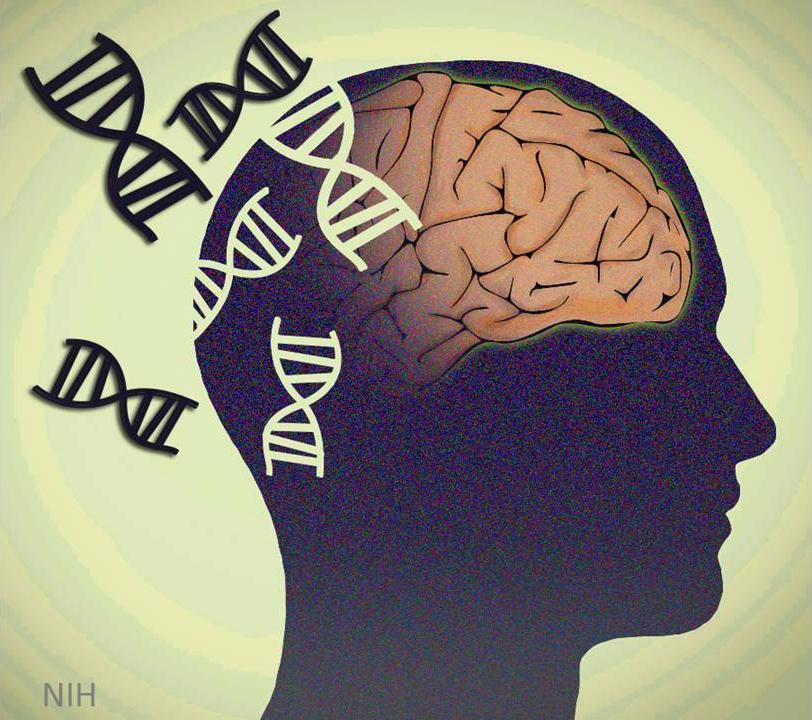
Medical conditions often run in families. For instance, if someone in your immediate family has high blood pressure, you are more likely to have it too. It is the same with mental disorders—often they run in families. NIMH is supporting research into human genetics to better understand why this occurs. This research has already led to the discovery of hundreds of gene variants that make us more or less likely to develop a mental disorder.
There are two types of genetic variation: common and rare. Common variation refers to DNA changes often seen in the general population, whereas rare variation is DNA changes found in only a small proportion of the population. Individually, most common gene variants have only a minor impact on the risk for a mental disorder. Instead, most disorders result from many common gene variants that, together, contribute to the risk for and severity of that disorder.
NIMH is committed to uncovering the role of genes in mental disorders with the aim of improving the lives of people who experience them. One of the many ways NIMH contributes to the discovery of common gene variants is by supporting the Psychiatric Genomics Consortium (PGC) . The consortium of almost 1,000 scientists across the globe, including ones in the NIMH Intramural Research Program and others conducting NIMH-supported research, is one of the largest and most innovative biological investigations in psychiatry.
Global collaborations such as the PGC are critical to amassing the immense sample sizes needed to identify common gene variants. Data from the consortium’s almost one million participants have already led to transformative insights about genetic contributors to mental illnesses and the genetic relationships of these illnesses to each other. To date, studies conducted as part of the consortium have uncovered common variation in over a dozen mental illnesses.
In contrast to common gene variants, rare gene variants are very uncommon in the general population. When they do occur, they often have a major impact on the occurrence of an illness, particularly when they disrupt gene function or regulation. Rare variants involving mutations in a single gene have been linked to several mental disorders, often through NIMH-supported research. For instance, a recent NIMH-funded study found that rare variation in 10 genes substantially increased the risk for schizophrenia. However, it is important to note that genetics is not destiny; even rare variants only raise the risk for mental disorders, but many other factors, including your environment and experiences, play important roles as well.
Because of the strong interest among researchers and the public in understanding how genes translate to changes in the brain and behavior, NIMH has developed a list of human genes associated with mental illnesses. These genes were identified through rare variation studies and are meant to serve as a resource for the research community. The list currently focuses on rare variants, but NIMH plans to continue expanding it as evidence accumulates for additional gene variants (rare or common).
Moreover, mental illnesses are a significant public health burden worldwide . For this reason, NIMH investments in genomics research extend across the globe. NIMH has established the Ancestral Populations Network (APN) to make genomics studies more diverse and shed light on how genetic variation contributes to mental disorders across populations. APN currently includes seven projects with more than 100 researchers across 25 sites worldwide.
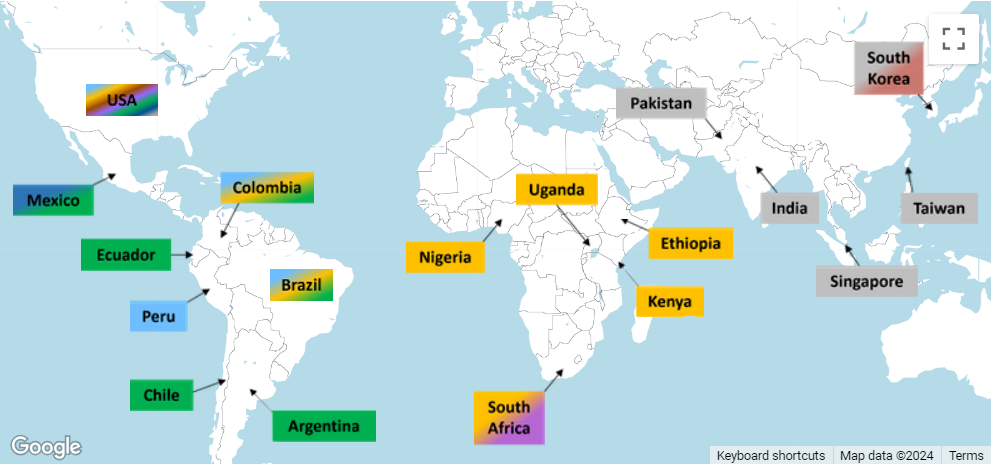
Connecting biology to behavior
While hundreds of individual genes have been linked to mental illnesses, the function of most of these genes in the brain remains poorly understood. But high-tech advances and the increased availability of computational tools are enabling researchers to begin unraveling the intricate roles played by genes.
In addition to identifying genetic variation that raises the risk for mental illnesses, NIMH supports research that will help us understand how genes contribute to human behavior. This information is critical to discovering approaches to diagnose, treat, and ultimately prevent or cure mental illnesses.
An NIMH-funded project called the PsychENCODE consortium focuses on understanding how genes impact brain function. PsychENCODE is furthering knowledge of how gene risk maps onto brain function and dysfunction by cataloging genomic elements in the human brain and studying the actions of different cell types. The PsychENCODE dataset currently includes multidimensional genetic data from the postmortem brains of thousands of people with and without mental disorders.
Findings from the first phase of PsychENCODE were published as a series of 11 papers examining functional genomics in the developing and adult brains and in mental disorders. A second batch of PsychENCODE papers will be published later this year. These findings help clarify the complex relationships between gene variants and the biological processes they influence.
PsychENCODE and other NIMH-supported projects are committed to sharing biospecimens quickly and openly to help speed research and discovery.

Facilitating these efforts is the NIMH Repository and Genomics Resource (NRGR) , where samples are stored and shared. NRGR includes hundreds of thousands of samples, such as DNA, RNA, and cell lines, from people with and without mental disorders, along with demographic and diagnostic information.

Another NIMH initiative to connect risk genes to brain function is Scalable and Systematic Neurobiology of Psychiatric and Neurodevelopmental Disorder Risk Genes (SSPsyGene) . This initiative uses cutting-edge techniques to characterize the biological functions of 250 mental health risk genes—within the cells where they are expressed—to better understand how those genes contribute to mental illnesses. By systematically characterizing the biological functions of risk genes in cells, SSPsyGene will empower researchers to learn about biological pathways that may serve as new targets for treatment.
Genes also affect behavior by providing the blueprint for neurons, the basic units of the nervous system. Neurons communicate with each other via circuits in the brain, which enables us to process, integrate, and convey information. NIMH supports many initiatives to study the foundational role of neural networks and brain circuits in shaping diverse mental health-related behaviors like mood, learning, memory, and motivation.
For instance, studies supported through a basic-to-translational science initiative at NIMH focus on modifying neural activity to improve cognitive, emotional, and social processing . Similarly, another new funding opportunity encourages studies in humans and animals examining how emotional and social cues are represented across brain circuits to help address a core deficit in many mental disorders. These studies will increase understanding of the biological mechanisms that support behavior throughout life and offer interventions to improve these functions in healthy and clinical populations.
Developing treatments and therapeutics
The gene discovery and biology-to-behavior programs described here will lay the foundation for delivering novel therapeutics. To be prepared to rapidly implement findings from this research, NIMH supports several initiatives to identify behavioral and biological markers for use in clinical studies and increase our ability to translate research into practice.
Through its therapeutics discovery research programs , NIMH advances early stage discovery and development studies in humans and early efficacy trials for mental disorders. Taking these efforts a step further, NIMH supports the National Cooperative Drug Discovery/Development Groups for the Treatment of Mental Disorders , which encourage public–private partnerships to accelerate the discovery and development of novel therapeutics and new biomarkers for use in human trials. Moreover, NIMH is one of several institutes and centers in the NIH Blueprint Neurotherapeutics Network , launched to enable neuroscientists in academia and biotechnology companies to develop new drugs for nervous system disorders.
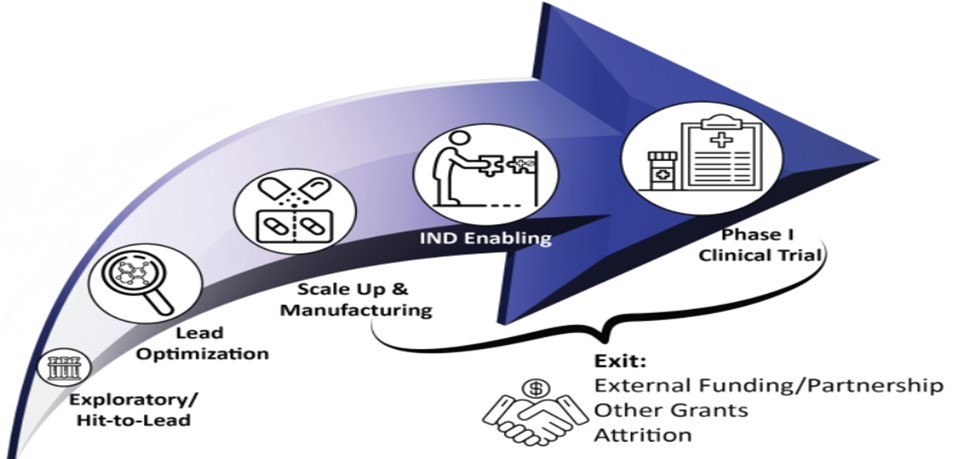
For the treatments of tomorrow, NIMH is building a new research program called Pre-Clinical Research on Gene Therapies for Rare Genetic Neurodevelopmental Disorders , which encourages early stage research to optimize gene therapies to treat disorders with prominent cognitive, social, or affective impairment. In parallel, NIMH’s Planning Grants for Natural History Studies of Rare Genetic Neurodevelopmental Disorders encourage the analysis of pre-existing data from people with rare disorders to learn about disease progression and enable future clinical trials with these populations.
NIMH's Division of Neuroscience and Basic Behavioral Science supports many different research projects that help us learn about genes and gene functions, how the brain develops and works, and impacts on behavior. By investing in basic neuroscience, genetics, and behavioral research, we're trying to find new targets for treatment and develop better therapies for mental disorders. We're hopeful these efforts will lead to new ways to treat and prevent mental illnesses in the near future and, ultimately, improve the lives of people in this country and across the globe.

- High contrast
- Our mandate
- Our history
- Annual report
- PRESS CENTRE
Search UNICEF

For every child, answers
Research and foresight that drive change for children
Latest work

Youth, Protests and the Polycrisis
Exploring how youth protests can help to build public support for change

Early Childhood Education Systems in Pacific Islands
Status report

Cash Plus Model for Safe Transitions to Healthy Adulthood
Examining the impacts of “Ujana Salama” (‘Safe Youth’ in Swahili), a cash plus programme targeting adolescents in the United Republic of Tanzania

The Impact of Valor Criança
Social cash transfer pilot programme in Angola

The Impact of the Cash Transfer Intervention
In the commune of Nsélé in Kinshasa, Democratic Republic of the Congo

Mitigating the socioeconomic impacts of COVID-19
With a cash transfer in peri-urban Kinshasa, Democratic Republic of the Congo

Prospects for Children: A Global Outlook 2024
Cooperation in a Fragmented World: Discover the eight trends that will define the year ahead for children and young people.

Data Must Speak: Chad
Reports and project briefs
Areas of work
Adolescent participation and civic engagement
Child protection
Climate crisis and the environment
Digital technology
Education and human capital
Health and well-being
Inclusion and equity
Poverty and social protection
Social and behaviour change
The State of the World’s Children
UNICEF’s flagship report – the most comprehensive analysis of global trends affecting children
Changing Childhood Project
What is childhood like today?
Prospects for Children: Global Outlook
An annual analysis of trends shaping the world and their impact on children
Report Card
Understanding child well-being everywhere
Our approach
UNICEF Innocenti works for and with children and young people to seek solutions to their most pressing challenges. As we focus on the rights and lives of children and young people, we always ask: Who else can we include? Will this work cause unintended harm? Are there events that could surprise us? Does this work drive change?
Events and insights

Six ways to make Loss and Damage finance work for children
Climate change is hurting kids. Here is how we can address the harm

The Antidote to Ageism
Understanding the importance of intergenerational collaboration

Celebrating women in education
A closer look at female teachers and school leaders

As they move
Child and youth experiences of migration, displacement and return in Afghanistan

Launch of UNICEF's Youth Foresight Playbook
28 November 2023, Dubai Future Forum

Expert consultation on age-related public expenditure
12-13 April 2023

The Third Annual KIX Symposium
12-13 October 2022

UNICEF at the International SBCC Summit 2022
5-9 December 2022

Become an Innocenti Insider
Receive the latest research and event invites in your inbox once a month

IMAGES
VIDEO
COMMENTS
Mind mapping is a brainstorming technique that allows users to deconstruct complex topics by creating a graphical representation of constituent subtopics and related themes. The aim of this article...
Mind mapping is used by people in business, education, government, the charity sector, and at home. In business, people use mind mapping for project planning, strategic thinking, and managing meetings. Mind mapping software helps teams to develop their ideas more collaboratively. Online mapping allows people to build off each other's ideas ...
Mind mapping can be used for generating, visualising, organising, note-taking, problem-solving, decision-making, revising and clarifying your university topic, so that you can get started with assessment tasks. Essentially, a mind map is used to 'brainstorm' a topic and is a great strategy for students.
Step 1: Start with a focus. You're creating a mind map for a specific reason, whether it's a subject that you're investigating, or information you need to present. This idea or thought needs be the center of your mind map. As such, most mind map makers will place your focus idea, or goal, in the middle of the page.
Mind maps offer yet another means. This chapter explores mind mapping, outlines its key features, and provides practical guidance for employing it in fieldwork, outlining some epistemological, ethical, and practical considerations for researchers. Finally, it canvasses its varied applications for qualitative health research.
A mind map is a diagram used to visually organize information into a hierarchy, ... Research Effectiveness. Cunningham (2005) conducted a user study in which 80% of the students thought "mindmapping helped them understand concepts and ideas in science". Other studies also report some subjective positive effects of the use of mind maps. ...
The mind maps represent the authors' concept of research methods at this time. The major aspects, rather than a complete picture, of research methods are illustrated in seven distinct areas ...
Mind maps are useful tools for qualitative researchers because they offer a mean to address researcher bias and ensure data are collected in ways that privilege participant experience. Qualitative ...
Mind Mapping is a learning tool that can be used to flush out your ideas and organize your thoughts using a diagram. You take your central idea and write out what you know about that particular area. Ask the who, what, where, and why questions surrounding your topic area. List key people, date ranges, policies, and even geographical areas that ...
4.6.3 Application of Mind Mapping to Setting Out the Research Tasks. Using mind mapping to draft the outline of your research proposal and plan the layout of your thesis can be a significant contributor to achieving success. The mind map guides the entire research process, allowing systematic flow in the research approach.
Psychological research has shown that mind mapping is an excellent tool for enhancing learning and understanding. For example, in a sample of 120 8th-grade students, researchers found that students who were taught using a mind mapping technique performed better on a subsequent test than students who were taught using traditional methods (Parikh, 2016).
Concept maps can be used to develop a research topic. They are a useful brainstorming tool. Concept maps can be used to study. Mapping what you know about a subject and examining the relationships between elements help you develop a greater understanding of the material.
Just what is needed for future research. Using a research mind map built off of a mind map template means the ability to start new research immediately. In addition, a mind map template built out of a diagramming tool helps speed up administrative tasks and gets you focused on the research portion.
2. Background of concept mapping. Concept maps may be defined as a type of diagram (Umoquit, Tso, Varga-Atkins, O'Brien, & Wheeldon, Citation 2013) or mind map (Wheeldon, Citation 2011); however, concept maps are further delineated depending on authors' theoretical and methodological orientations.Novak and Gowin (Citation 1984) originally used concept maps to facilitate meaningful learning ...
Additionally, mind maps can be an optimal method for collaborative brainstorming. Psychological research has also shown that mind mapping is an excellent tool for enhancing learning and understanding.
Here are three of the best online mind mapping tools available today: 1. MindManager by MindJet: This tool is for business users — a professional mind map maker with MS Office integration. You could even pick a mind map template in the tool to get started. Source: MindManager. 2.
Context In a health service environment where timescales for patient participation in service design are short and resources scarce, a balance needs to be achieved between research rigour and the timeliness and utility of the findings of patient participation processes. Objective To develop a pragmatic mind mapping approach to managing the qualitative data from patient participation processes.
These findings were consistent with research results reported by Chen and Zhang 13 and Chen and Zhao. 14 Therefore, our findings confirm that the application of mind mapping in teaching can improve the critical thinking ability of nursing students. 15,16 Mind mapping can be used to effectively integrate and optimize learning resources, helping ...
We looked at a variety of surveys and research studies to find the seven biggest benefits of mind mapping. According to research, mind mapping improves learning, information recall, productivity, creativity, and more. 1. It Enables Meaningful Learning. In " Making Learning Visible: The Role of Concept Mapping in Higher Education ...
Mind map have also proven effective as a language learning material for students; for example, Petrova and Kazarova discussed the feasibility of using mind maps as a teaching and learning tool in foreign language acquisition, as it ... For future research, it might be worth involving students in a variety of mind mapping activities ...
Mind mapping is a visualization tool used in instruction that can be applied by learners to generate ideas, take notes, organize thinking, and develop concepts. Instruction using mind mapping is becoming increasingly commonly used in education. However, research has produced inconsistent results regarding the effectiveness of mind mapping-based instruction on student learning outcomes. Using ...
Mind mapping is a way of representing information and relationships visually. Information is presented in the form of a "mind map," a type of spider diagram. ... Research shows that it can make learning fun for students due to the creative freedom that comes with using your imagination in forming a mind map! Planning and organization.
A research organizer mind map is an innovative tool that can facilitate and enhance the process of organizing research. It operates on the principle of visual learning, providing a bird's eye view of the research topic, sub-topics, concepts, and connections among them. With this tool, large amounts of information can be structured and ...
Mind mapping to plan your research. This video demonstrates how to to use the mind-mapping technique to refine your research ideas and identify keywords. Pre-search for topic development. Before you begin searching in library databases to find academic sources, it's useful to have some background information about your topic. This video ...
The Division of Neuroscience and Basic Behavioral Science (DNBBS) at the National Institute of Mental Health (NIMH) supports research on basic neuroscience, genetics, and basic behavioral science. These are foundational pillars in the quest to decode the human mind and unravel the complexities of mental illnesses. At NIMH, we are committed to supporting and conducting genomics research as a ...
Research and foresight that drive change for children Our projects and reports. Latest work Report. Early Childhood Education Systems in Pacific Islands Status report See the full report. Report. Cash Plus Model for Safe Transitions to Healthy Adulthood